
List of birds of Oman
Encyclopedia

Oman
Oman , officially called the Sultanate of Oman , is an Arab state in southwest Asia on the southeast coast of the Arabian Peninsula. It is bordered by the United Arab Emirates to the northwest, Saudi Arabia to the west, and Yemen to the southwest. The coast is formed by the Arabian Sea on the...
includes a total of 494 species, of which 5 have been introduced
Introduced species
An introduced species — or neozoon, alien, exotic, non-indigenous, or non-native species, or simply an introduction, is a species living outside its indigenous or native distributional range, and has arrived in an ecosystem or plant community by human activity, either deliberate or accidental...
by humans, and 146 are rare or accidental. The Ostrich
Ostrich
The Ostrich is one or two species of large flightless birds native to Africa, the only living member of the genus Struthio. Some analyses indicate that the Somali Ostrich may be better considered a full species apart from the Common Ostrich, but most taxonomists consider it to be a...
is extirpated
Local extinction
Local extinction, also known as extirpation, is the condition of a species which ceases to exist in the chosen geographic area of study, though it still exists elsewhere...
in Oman and is not included in the species count. 12 species are globally threatened.
This list's taxonomic
Taxonomy
Taxonomy is the science of identifying and naming species, and arranging them into a classification. The field of taxonomy, sometimes referred to as "biological taxonomy", revolves around the description and use of taxonomic units, known as taxa...
treatment (designation and sequence of orders, families, and species) and nomenclature (common and scientific names) generally follow the conventions of Clements
James Clements
Dr. James Franklin Clements was an ornithologist, author and very successful businessman. He was born in New York....
's 6th edition with a few changes following the list of the Ornithological Society of the Middle East. The family accounts at the beginning of each heading reflect the Clements taxonomy, as do the species counts found in each family account. Introduced and accidental species are included in the total counts for Oman.
The following tags have been used to highlight certain relevant categories, but not all species fall into one of these categories. Those that do not are commonly occurring, native species.
- (A) Accidental A species that rarely or accidentally occurs in Oman.
- (I) Introduced A species introduced to Oman as a consequence, direct or indirect, of human actions.
- (Ex) Extirpated A species that no longer occurs in Oman although populations exist elsewhere.
| Table of contents |
|---|
Non-passerines: Ostriches . Grebes . Shearwaters and petrels . Storm-petrels . Tropicbirds . Pelicans . Boobies and gannets . Cormorants . Frigatebirds . Bitterns, herons and egrets . Storks . Ibises and spoonbills . Flamingos . Ducks, geese and swans . Osprey . Hawks, kites and eagles . Falcons . Partridges and quails . Buttonquails . Cranes . Rails, crakes, gallinules, and coots . Bustards . Jacanas . Painted snipe . Crab Plover . Oystercatchers . Avocets and stilts . Thick-knees . Pratincoles and coursers . Plovers and lapwings . Sandpipers and allies . Skuas . Gulls . Terns . Skimmers . Sandgrouse . Pigeons and doves . Parrots . Cuckoos . Barn owls . Typical owls . Nightjars . Swifts . Kingfishers . Bee-eaters . Typical rollers . Hoopoes . Woodpeckers and allies . |
Passerines: Larks . Swallows and martins . Wagtails and pipits . Bulbuls . Grey Hypocolius . Accentors . Thrushes . Cisticolas and allies . Old World warblers . Old World flycatchers and chats . Monarch flycatchers . Babblers . Penduline tits . Sunbirds . White-eyes . Old World orioles . Shrikes . Bushshrikes and allies . Drongos . Crows, ravens and magpies . Starlings . Weavers and allies . Waxbills and allies . Buntings, Sparrows . Finches . Sparrows . |
See also References |
Ostriches
Order: Struthioniformes. Family: StruthionidaeThe Ostrich is a flightless bird native to Africa. It is the largest living species of bird. It is distinctive in its appearance, with a long neck and legs and the ability to run at high speeds.
- OstrichOstrichThe Ostrich is one or two species of large flightless birds native to Africa, the only living member of the genus Struthio. Some analyses indicate that the Somali Ostrich may be better considered a full species apart from the Common Ostrich, but most taxonomists consider it to be a...
Struthio camelus (Ex)
Grebes
-_breeding_plumage-_in_hyderabad,_ap_w_img_7648.jpg)
Grebe
Grebe
A grebe is a member of the Podicipediformes order, a widely distributed order of freshwater diving birds, some of which visit the sea when migrating and in winter...
s are small to medium-large sized freshwater diving birds. They have lobed toes, and are excellent swimmers and divers. However, they have their feet placed far back on the body, making them quite ungainly on land. There are about 19 species worldwide and 3 species which occur in Oman.
- Little GrebeLittle GrebeThe Little Grebe , also known as Dabchick, member of the grebe family of water birds. At 23 to 29 cm in length it is the smallest European member of its family. It is commonly found in open bodies of water across most of its range.-Description:The Little Grebe is a small water bird with a pointed...
Tachybaptus ruficollis - Great Crested GrebeGreat Crested GrebeThe Great Crested Grebe is a member of the grebe family of water birds.- Description :The Great Crested Grebe is long with a wingspan. It is an excellent swimmer and diver, and pursues its fish prey underwater. The adults are unmistakable in summer with head and neck decorations...
Podiceps cristatus (A) - Black-necked GrebeBlack-necked GrebeThe Black-necked Grebe, Podiceps nigricollis, known in North America as the Eared Grebe, is a member of the grebe family of water birds. It occurs on every continent except Australia and Antarctica.-Taxonomy:There are three subspecies:*P. n...
Podiceps nigricollis
Shearwaters and petrels

Procellariiformes
Procellariiformes is an order of seabirds that comprises four families: the albatrosses, petrels and shearwaters, storm petrels, and diving petrels...
. Family: Procellariidae
Procellariidae
The family Procellariidae is a group of seabirds that comprises the fulmarine petrels, the gadfly petrels, the prions, and the shearwaters. This family is part of the bird order Procellariiformes , which also includes the albatrosses, the storm-petrels, and the diving petrels.The procellariids are...
The procellariids are the main group of medium-sized 'true petrels', characterised by united nostrils with a medium septum, and a long outer functional primary. There are about 77 species worldwide and 7 species which occur in Oman.
- Jouanin's PetrelJouanin's PetrelJouanin's Petrel is a species of seabird in the Procellariidae family.It is found in Djibouti, Indonesia, Pakistan, Kenya, Maldives, Mozambique, Oman, Saudi Arabia, Seychelles, Somalia, and Yemen....
Bulweria fallax - Streaked ShearwaterStreaked ShearwaterThe Streaked Shearwater, Calonectris leucomelas is a species of seabird. The bird is 48 cm in size, with a 122 cm wingspan. This species is pelagic, but also occurs in inshore waters. It occurs in the Pacific Ocean, nesting in Japan and many of its offshore islands. After breeding, the Streaked...
Calonectris leucomelas (A) - Cory's ShearwaterCory's ShearwaterThe Cory's Shearwater is a large shearwater in the seabird family Procellariidae.This species breeds on islands and cliffs in the Mediterranean, with the odd outpost on the Atlantic coast of Iberia. The nest is on open ground or among rocks or less often in a burrow where one white egg is laid,...
Calonectris diomedea (A) - Flesh-footed ShearwaterFlesh-footed ShearwaterThe Flesh-footed Shearwater, Puffinus carneipes, is a small shearwater. Its plumage is black. It has pale pinkish feet, and a pale bill with a black tip. Together with the equally light-billed Pink-footed Shearwater, it forms the Hemipuffinus group, a superspecies which may or may not have an...
Puffinus carneipes - Wedge-tailed ShearwaterWedge-tailed ShearwaterThe Wedge-tailed Shearwater, Puffinus pacificus is a medium-large shearwater in the seabird family Procellariidae. It is one of the shearwater species that is sometimes referred to as a Muttonbird, like the Sooty Shearwater of New Zealand and the Short-tailed Shearwater of Australia...
Puffinus pacificus - Sooty ShearwaterSooty ShearwaterThe Sooty Shearwater is a medium-large shearwater in the seabird family Procellariidae. In New Zealand it is also known by its Māori name tītī and as "muttonbird", like its relatives the Wedge-tailed Shearwater and the Australian Short-tailed Shearwater The Sooty Shearwater (Puffinus griseus) is...
Puffinus griseus (A) - Persian Shearwater Puffinus persicus
Storm-petrels
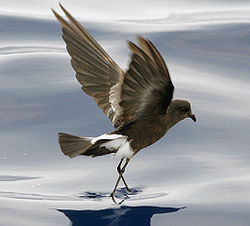
Procellariiformes
Procellariiformes is an order of seabirds that comprises four families: the albatrosses, petrels and shearwaters, storm petrels, and diving petrels...
. Family: Hydrobatidae
The storm-petrel
Storm-petrel
Storm petrels are seabirds in the family Hydrobatidae, part of the order Procellariiformes. These smallest of seabirds feed on planktonic crustaceans and small fish picked from the surface, typically while hovering. The flight is fluttering and sometimes bat-like.Storm petrels have a cosmopolitan...
s are relatives of the petrel
Petrel
Petrels are tube-nosed seabirds in the bird order Procellariiformes. The common name does not indicate relationship beyond that point, as "petrels" occur in three of the four families within that group...
s, and are the smallest of sea-birds. They feed on plankton
Plankton
Plankton are any drifting organisms that inhabit the pelagic zone of oceans, seas, or bodies of fresh water. That is, plankton are defined by their ecological niche rather than phylogenetic or taxonomic classification...
ic crustaceans and small fish picked from the surface, typically while hovering. The flight is fluttering and sometimes bat
Bat
Bats are mammals of the order Chiroptera "hand" and pteron "wing") whose forelimbs form webbed wings, making them the only mammals naturally capable of true and sustained flight. By contrast, other mammals said to fly, such as flying squirrels, gliding possums, and colugos, glide rather than fly,...
-like. There are about 20 species worldwide and 4 species which occur in Oman.
- Wilson's Storm-PetrelWilson's Storm-petrelWilson's Storm Petrel , also known as Wilson's Petrel, is a small seabird of the storm-petrel family. It is one of the most abundant bird species in the world and has a circumpolar distribution mainly in the seas of the southern hemisphere but extending northwards during the summer of the northern...
Oceanites oceanicus - White-faced Storm-PetrelWhite-faced Storm-petrelThe White-faced Storm Petrel , also known as White-faced Petrel is a small seabird of the storm-petrel family. It is the only member of the monotypic genus Pelagodroma....
Pelagodroma marina (A) - Black-bellied Storm-PetrelBlack-bellied Storm-petrelThe Black-bellied Storm Petrel is a species of seabird in the Hydrobatidae family.It is found in Antarctica, Argentina, Australia, Bouvet Island, Brazil, Chile, Falkland Islands, French Polynesia, French Southern Territories, Madagascar, Mozambique, New Zealand, Oman, Peru, Saint Helena, São Tomé...
Fregetta tropica (A) - Swinhoe's Storm-PetrelSwinhoe's Storm-petrelSwinhoe's Storm Petrel, Oceanodroma monorhis also known as Swinhoe's Petrel is a small seabird of the storm-petrel family Hydrobatidae....
Oceanodroma monorhis
Tropicbirds
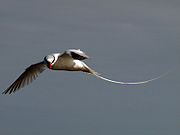
Pelecaniformes
The Pelecaniformes is a order of medium-sized and large waterbirds found worldwide. As traditionally—but erroneously—defined, they encompass all birds that have feet with all four toes webbed. Hence, they were formerly also known by such names as totipalmates or steganopodes...
. Family: Phaethontidae
Tropicbird
Tropicbird
Tropicbirds are a family, Phaethontidae, of tropical pelagic seabirds now classified in their own order Phaethontiformes. Their relationship to other living birds is unclear, and they appear to have no close relatives. There are three species in one genus, Phaethon...
s are slender white birds of tropical oceans, with exceptionally long central tail feathers. Their heads and long wings have black markings. There are 3 species worldwide and 1 species which occurs in Oman.
- Red-billed TropicbirdRed-billed TropicbirdThe Red-billed Tropicbird, Phaethon aethereus, also known as the Boatswain Bird is a tropicbird, one of three closely related seabirds of tropical oceans.-Distribution and habitat:...
Phaethon aethereus
Pelicans
Order: PelecaniformesPelecaniformes
The Pelecaniformes is a order of medium-sized and large waterbirds found worldwide. As traditionally—but erroneously—defined, they encompass all birds that have feet with all four toes webbed. Hence, they were formerly also known by such names as totipalmates or steganopodes...
. Family: Pelecanidae
Pelican
Pelican
A pelican, derived from the Greek word πελεκυς pelekys is a large water bird with a large throat pouch, belonging to the bird family Pelecanidae....
s are large water birds with a distinctive pouch under the beak. As with other members of the order Pelecaniformes, they have webbed feet with four toes. There are about 8 species worldwide and 3 species which occur in Oman.
- Great White Pelican Pelecanus onocrotalus (A)
- Pink-backed PelicanPink-backed PelicanThe Pink-backed Pelican is a member of the pelican family of birds. It is a resident breeder in Africa, southern Arabia and apparently extinct in Madagascar in swamps and shallow lakes.-Description:...
Pelecanus rufescens (A) - Dalmatian PelicanDalmatian PelicanThe Dalmatian Pelican is a member of the pelican family. It breeds from southeastern Europe to India and China in swamps and shallow lakes. The nest is a crude heap of vegetation....
Pelecanus crispus (A)
Boobies and gannets

Pelecaniformes
The Pelecaniformes is a order of medium-sized and large waterbirds found worldwide. As traditionally—but erroneously—defined, they encompass all birds that have feet with all four toes webbed. Hence, they were formerly also known by such names as totipalmates or steganopodes...
. Family: Sulidae
Sulidae
The bird family Sulidae comprises the gannets and boobies. Collectively called sulidas, they are medium-large coastal seabirds that plunge-dive for fish and similar prey. The ten species in this family are often considered congeneric in older sources, placing all in the genus Sula...
The sulids comprise the gannet
Gannet
Gannets are seabirds comprising the genus Morus, in the family Sulidae, closely related to the boobies.The gannets are large black and white birds with yellow heads. They have long pointed wings and long bills. Northern gannets are the largest seabirds in the North Atlantic, with a wingspan of up...
s and boobies
Booby
A booby is a seabird in the genus Sula, part of the Sulidae family. Boobies are closely related to the gannets , which were formerly included in Sula.-Description:...
. Both groups comprise medium-to-large coastal sea-birds that plunge-dive for fish. There are about 10 species worldwide and 4 species which occur in Oman.
- Cape GannetCape GannetThe Cape Gannet, Morus capensis, originally Sula capensis, is a large seabird of the gannet family, Sulidae.They are easily identified by their large size, black and white plumage and distinctive yellow crown and hindneck...
Morus capensis (A) - Masked BoobyMasked BoobyThe Masked Booby, Sula dactylatra, is a large seabird of the booby family, Sulidae. This species breeds on islands in tropical oceans, except in the eastern Atlantic; in the eastern Pacific it is replaced by the Nazca Booby, Sula granti, which was formerly regarded as a subspecies of Masked Booby...
Sula dactylatra - Red-footed BoobyRed-footed BoobyThe Red-footed Booby, Sula sula, is a large seabird of the booby family, Sulidae. As suggested by the name, adults always have red feet, but the colour of the plumage varies. They are powerful and agile fliers, but they are clumsy in takeoffs and landings...
Sula sula (A) - Brown BoobyBrown BoobyThe Brown Booby is a large seabird of the booby family, Sulidae. The adult brown booby reaches about in length. Its head and upper body are covered in dark brown, with the remainder being a contrasting white. The juvenile form is gray-brown with darkening on the head, wings and tail...
Sula leucogaster
Cormorants

Pelecaniformes
The Pelecaniformes is a order of medium-sized and large waterbirds found worldwide. As traditionally—but erroneously—defined, they encompass all birds that have feet with all four toes webbed. Hence, they were formerly also known by such names as totipalmates or steganopodes...
. Family: Phalacrocoracidae
The Phalacrocoracidae is a family of medium-to-large coastal, fish-eating sea-birds that includes cormorants and shags. Plumage colouration varies with the majority having mainly dark plumage, some species being black and white, and a few being colourful. There are about 39 species worldwide and 2 species which occur in Oman.
- Great CormorantGreat CormorantThe Great Cormorant , known as the Great Black Cormorant across the Northern Hemisphere, the Black Cormorant in Australia and the Black Shag further south in New Zealand, is a widespread member of the cormorant family of seabirds...
Phalacrocorax carbo - Socotra CormorantSocotra CormorantThe Socotra Cormorant, Phalacrocorax nigrogularis, is a threatened species of cormorant that is endemic to the Persian Gulf and the south-east coast of the Arabian Peninsula. It is also sometimes known as the Socotran Cormorant or, more rarely, as the Socotra Shag. Individuals occasionally...
Phalacrocorax nigrogularis
Frigatebirds
Order: PelecaniformesPelecaniformes
The Pelecaniformes is a order of medium-sized and large waterbirds found worldwide. As traditionally—but erroneously—defined, they encompass all birds that have feet with all four toes webbed. Hence, they were formerly also known by such names as totipalmates or steganopodes...
. Family: Fregatidae
Frigatebird
Frigatebird
The frigatebirds are a family, Fregatidae, of seabirds. There are five species in the single genus Fregata. They are also sometimes called Man of War birds or Pirate birds. Since they are related to the pelicans, the term "frigate pelican" is also a name applied to them...
s are large sea-birds usually found over tropical oceans. They are large, black and white or completely black, with long wings and deeply-forked tails. The males have inflatable coloured throat pouches. They do not swim or walk, and cannot take off from a flat surface. Having the largest wingspan to body weight ratio of any bird, they are essentially aerial, able to stay aloft for more than a week. There are 5 species worldwide and 2 species which occur in Oman.
- Great FrigatebirdGreat FrigatebirdThe Great Frigatebird is a large dispersive seabird in the frigatebird family. Major nesting populations are found in the Pacific and Indian Oceans, as well as a population in the South Atlantic....
Fregata minor (A) - Lesser FrigatebirdLesser FrigatebirdThe Lesser Frigatebird, Fregata ariel, is a species of frigatebird.It nests in Australia, among other locations.There is a single record from the Western Palearctic, from Eilat in the Gulf of Aqaba....
Fregata ariel (A)
Bitterns, herons and egrets
.jpg)
Ciconiiformes
Traditionally, the order Ciconiiformes has included a variety of large, long-legged wading birds with large bills: storks, herons, egrets, ibises, spoonbills, and several others. Ciconiiformes are known from the Late Eocene...
. Family: Ardeidae
The family Ardeidae contains the bittern
Bittern
Bitterns are a classification of birds in the heron family, Ardeidae, a family of wading birds. Species named bitterns tend to be the shorter-necked, often more secretive members of this family...
s, heron
Heron
The herons are long-legged freshwater and coastal birds in the family Ardeidae. There are 64 recognised species in this family. Some are called "egrets" or "bitterns" instead of "heron"....
s and egret
Egret
An egret is any of several herons, most of which are white or buff, and several of which develop fine plumes during the breeding season. Many egrets are members of the genera Egretta or Ardea which contain other species named as herons rather than egrets...
s. Herons and egrets are medium to large sized wading birds with long necks and legs. Bitterns tend to be shorter necked and more wary. Unlike other long-necked birds suck as storks, ibises and spoonbills, members of Ardeidae fly with their necks retracted. There are about 63 species worldwide and 17 species which occur in Oman.
- Grey HeronGrey HeronThe Grey Heron , is a wading bird of the heron family Ardeidae, native throughout temperate Europe and Asia and also parts of Africa. It is resident in the milder south and west, but many birds retreat in winter from the ice in colder regions...
Ardea cinerea - Black-headed HeronBlack-headed HeronThe Black-headed Heron is a wading bird of the heron family Ardeidae, common throughout much of sub-Saharan Africa and Madagascar. It is mainly resident but some west African birds move further north in the rainy season....
Ardea melanocephala (A) - Goliath HeronGoliath HeronThe Goliath Heron is a very large wading bird of the heron family Ardeidae. It is found in sub-Saharan Africa, with smaller numbers in Southwest and South Asia.-Description:This is the world's largest heron...
Ardea goliath (A) - Purple HeronPurple HeronThe Purple Heron is a wading bird in the heron family Ardeidae, breeding in Africa, central and southern Europe, and southern and eastern Asia. The European populations are migratory, wintering in tropical Africa; the more northerly Asian populations also migrate further south within Asia...
Ardea purpurea - Great EgretGreat EgretThe Great Egret , also known as the Great White Egret or Common Egret, White Heron, or Great White Heron, is a large, widely-distributed egret. Distributed across most of the tropical and warmer temperate regions of the world, in southern Europe it is rather localized...
Ardea alba - Black HeronBlack HeronThe Black Heron also known as the Black Egret, is an African heron. It is a medium-sized , black-plumaged heron with yellow legs and feet. It is found south of the Sahara Desert, including Madagascar, and prefers shallow open waters, such as the edges of freshwater lakes and ponds...
Egretta ardesiaca (A) - Intermediate EgretIntermediate EgretThe Intermediate Egret, Median Egret, or Yellow-billed Egret is a medium-sized heron. It is a resident breeder from east Africa across tropical southern Asia to Australia. It often nests in colonies with other herons, usually on platforms of sticks in trees or shrubs...
Egretta intermedia - Little EgretLittle EgretThe Little Egret is a small white heron. It is the Old World counterpart to the very similar New World Snowy Egret.-Subspecies:Depending on authority, two or three subspecies of Little Egret are currently accepted....
Egretta garzetta - Western Reef-Heron Egretta gularis
- Squacco HeronSquacco HeronThe Squacco Heron, Ardeola ralloides, is a small heron, long, of which the body is , with wingspan. It is of Old World origins, breeding in southern Europe and the Greater Middle East.-Behaviour:...
Ardeola ralloides - Indian Pond-Heron Ardeola grayii
- Cattle EgretCattle EgretThe Cattle Egret is a cosmopolitan species of heron found in the tropics, subtropics and warm temperate zones. It is the only member of the monotypic genus Bubulcus, although some authorities regard its two subspecies as full species, the Western Cattle Egret and the Eastern Cattle Egret...
Bubulcus ibis - Striated HeronStriated HeronThe Striated Heron, Butorides striata, also known as Mangrove Heron, Little Heron or Green-backed Heron, is a small heron. Striated Herons are mostly non-migratory and noted for some interesting behavioral traits. Their breeding habitat is small wetlands in the Old World tropics from west Africa to...
Butorides striata - Black-crowned Night-Heron Nycticorax nycticorax
- Yellow BitternYellow BitternThe Yellow Bittern is a small bittern. It is of Old World origins, breeding in much of the Indian Subcontinent, east to Japan and Indonesia. It is mainly resident, but some northern birds migrate short distances...
Ixobrychus sinensis - Little BitternLittle BitternThe Little Bittern is a wading bird in the heron family Ardeidae, native to the Old World, breeding in Africa, central and southern Europe, western and southern Asia, and Madagascar. Birds from temperate regions in Europe and western Asia are migratory, wintering in Africa and further south in...
Ixobrychus minutus - Great BitternGreat BitternThe Eurasian Bittern or Great Bittern is a wading bird of the heron family Ardeidae. It is one of the species to which the Agreement on the Conservation of African-Eurasian Migratory Waterbirds applies.-Etymology:...
Botaurus stellaris
Storks

Ciconiiformes
Traditionally, the order Ciconiiformes has included a variety of large, long-legged wading birds with large bills: storks, herons, egrets, ibises, spoonbills, and several others. Ciconiiformes are known from the Late Eocene...
. Family: Ciconiidae
Storks are large, long-legged, long-necked, wading birds with long, stout bills. Storks are mute; bill-clattering is an important mode of stork communication at the nest. Their nests can be large and may be reused for many years. Many species are migratory. There are about 19 species worldwide and 3 species which occur in Oman.
- Black StorkBlack StorkThe Black Stork Ciconia nigra is a large wading bird in the stork family Ciconiidae. It is a widespread, but rare, species that breeds in the warmer parts of Europe, predominantly in central and eastern regions. This is a shy and wary species, unlike the closely related White Stork. It is seen in...
Ciconia nigra (A) - Abdim's StorkAbdim's StorkThe Abdim's Stork, also known as White-bellied Stork, is a black stork with grey legs, red knees and feet, grey bill and white underparts. It has red facial skin in front of eye and blue skin near the bill in breeding season...
Ciconia abdimii - White StorkWhite StorkThe White Stork is a large bird in the stork family Ciconiidae. Its plumage is mainly white, with black on its wings. Adults have long red legs and long pointed red beaks, and measure on average from beak tip to end of tail, with a wingspan...
Ciconia ciconia
Ibises and spoonbills
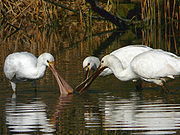
Ciconiiformes
Traditionally, the order Ciconiiformes has included a variety of large, long-legged wading birds with large bills: storks, herons, egrets, ibises, spoonbills, and several others. Ciconiiformes are known from the Late Eocene...
. Family: Threskiornithidae
Threskiornithidae
The family Threskiornithidae includes 34 species of large terrestrial and wading birds, falling into two subfamilies, the ibises and the spoonbills. It was formerly known as Plataleidae. The spoonbills and ibises were once thought to be related to other groups of long-legged wading birds in the...
The Threskiornithidae is a family of large terrestrial and wading birds which includes the ibis
Ibis
The ibises are a group of long-legged wading birds in the family Threskiornithidae....
es and spoonbill
Spoonbill
Spoonbills are a group of large, long-legged wading birds in the family Threskiornithidae, which also includes the Ibises.All have large, flat, spatulate bills and feed by wading through shallow water, sweeping the partly opened bill from side to side...
s. They have long, broad wings with 11 primary and about 20 secondary feathers. They are strong fliers and despite their size and weight, very capable soarers. There are about 33 species worldwide and 4 species which occur in Oman.
- Sacred IbisSacred IbisThe African Sacred Ibis is a species of ibis.-Description:An adult individual is 68 cm long with all-white body plumage apart from dark plumes on the rump. The bald head and neck, thick curved bill and legs are black. The white wings show a black rear border in flight...
Threskiornis aethiopicus (A) - Glossy IbisGlossy IbisThe Glossy Ibis is a wading bird in the ibis family Threskiornithidae.This is the most widespread ibis species, breeding in scattered sites in warm regions of Europe, Asia, Africa, Australia, and the Atlantic and Caribbean region of the Americas...
Plegadis falcinellus - Eurasian Spoonbill Platalea leucorodia
- African SpoonbillAfrican SpoonbillThe African Spoonbill is a long-legged wading bird of the ibis and spoonbill family Threskiornithidae. The species is widespread across Africa and Madagascar, including Botswana, Kenya, Mozambique, Namibia, South Africa, and Zimbabwe. It lives in marshy wetlands with some open shallow water and...
Platalea alba (A)
Flamingos
Order: Phoenicopteriformes. Family: PhoenicopteridaeFlamingo
Flamingo
Flamingos or flamingoes are gregarious wading birds in the genus Phoenicopterus , the only genus in the family Phoenicopteridae...
s are gregarious wading birds, usually 3 to 5 feet (1.5 m) high, found in both the Western and Eastern Hemispheres. They are more numerous in the latter. Flamingos filter-feed on shellfish and algae. Their oddly-shaped beaks are specially adapted to separate mud and silt from the food they consume, and are uniquely used upside-down. There are about 6 species worldwide and 2 species which occur in Oman.
- Greater FlamingoGreater FlamingoThe Greater Flamingo is the most widespread species of the flamingo family. It is found in parts of Africa, southern Asia , and southern Europe...
Phoenicopterus roseus - Lesser FlamingoLesser FlamingoThe Lesser Flamingo is a species in the flamingo family of birds that resides in Africa and in southern Asia...
Phoenicopterus minor (A)
Ducks, geese and swans
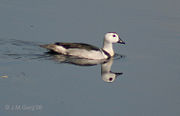
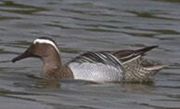
Anseriformes
The order Anseriformes contains about 150 living species of birds in three extant families: the Anhimidae , Anseranatidae , and the Anatidae, which includes over 140 species of waterfowl, among them the ducks, geese, and swans.All species in the order are highly adapted for an aquatic existence at...
. Family: Anatidae
Anatidae
Anatidae is the biological family of birds that includes ducks, geese and swans. The family has a cosmopolitan distribution, occurring on all the world's continents except Antarctica and on most of the world's islands and island groups...
The family Anatidae includes the duck
Duck
Duck is the common name for a large number of species in the Anatidae family of birds, which also includes swans and geese. The ducks are divided among several subfamilies in the Anatidae family; they do not represent a monophyletic group but a form taxon, since swans and geese are not considered...
s and most duck-like waterfowl, such as geese
Goose
The word goose is the English name for a group of waterfowl, belonging to the family Anatidae. This family also includes swans, most of which are larger than true geese, and ducks, which are smaller....
and swan
Swan
Swans, genus Cygnus, are birds of the family Anatidae, which also includes geese and ducks. Swans are grouped with the closely related geese in the subfamily Anserinae where they form the tribe Cygnini. Sometimes, they are considered a distinct subfamily, Cygninae...
s. These are birds that are modified for an aquatic existence with webbed feet, flattened bills and feathers that are excellent at shedding water due to an oily coating. There are 159 species worldwide and 26 species which occur in Oman.
- Fulvous Whistling-Duck Dendrocygna bicolor (A)
- Lesser Whistling-Duck Dendrocygna javanica (A)
- Mute SwanMute SwanThe Mute Swan is a species of swan, and thus a member of the duck, goose and swan family Anatidae. It is native to much of Europe and Asia, and the far north of Africa. It is also an introduced species in North America, Australasia and southern Africa. The name 'mute' derives from it being less...
Cygnus olor (A) - Whooper SwanWhooper SwanThe Whooper Swan , Cygnus cygnus, is a large Northern Hemisphere swan. It is the Eurasian counterpart of the North American Trumpeter Swan. An old name for the Whooper Swan is Elk; it is so called in Francis Willughby and John Ray's Ornithology of 1676.-Description:The Whooper Swan is similar in...
Cygnus cygnus (A) - Bewick's SwanBewick's SwanThe Tundra Swan is a small Holarctic swan. The two taxa within it are usually regarded as conspecific, but are also sometimes split into two species, Cygnus bewickii of the Palaearctic and the Whistling Swan, C. columbianus proper, of the Nearctic...
Cygnus columbianus (A) - Greater White-fronted Goose Anser albifrons
- Lesser White-fronted GooseLesser White-fronted GooseThe Lesser White-fronted Goose is a goose closely related to the larger White-fronted Goose .It breeds in northernmost Asia, but it is a scarce breeder in Europe. There is a re-introduction scheme in Fennoscandia....
Anser erythropus (A) - Greylag GooseGreylag GooseThe Greylag Goose , Anser anser, is a bird with a wide range in the Old World. It is the type species of the genus Anser....
Anser anser - Egyptian GooseEgyptian GooseThe Egyptian Goose is a member of the duck, goose and swan family Anatidae. It is in the shelduck subfamily Tadorninae, and is the only extant member of the genus Alopochen...
Alopochen aegyptiacus (A) - Ruddy ShelduckRuddy ShelduckThe Ruddy Shelduck, Tadorna ferruginea, is a member of the duck, goose and swan family Anatidae. It is in the shelduck subfamily Tadorninae...
Tadorna ferruginea - Common ShelduckCommon ShelduckThe Common Shelduck is a waterfowl species shelduck genus Tadorna. It is widespread and common in Eurasia, mainly breeding in temperate and wintering in subtropical regions; in winter, it can also be found in the Maghreb...
Tadorna tadorna - Comb DuckComb DuckThe Knob-billed Duck , or Comb Duck, is an unusual, pan-tropical duck, found in tropical wetlands in sub-Saharan Africa, Madagascar and south Asia from Pakistan to Laos and extreme southern China...
Sarkidiornis melanotos (A) - Cotton Pygmy-goose Nettapus coromandelianus
- Eurasian Wigeon Anas penelope
- GadwallGadwallThe Gadwall is a common and widespread duck of the family Anatidae.- Description :The Gadwall is 46–56 cm long with a 78–90 cm wingspan. The male is slightly larger than the female, weighing on average 990 g against her 850 g...
Anas strepera - Eurasian Teal Anas crecca
- MallardMallardThe Mallard , or Wild Duck , is a dabbling duck which breeds throughout the temperate and subtropical Americas, Europe, Asia, and North Africa, and has been introduced to New Zealand and Australia....
Anas platyrhynchos - Northern PintailNorthern PintailThe Pintail or Northern Pintail is a widely occurring duck which breeds in the northern areas of Europe, Asia and North America. It is strongly migratory and winters south of its breeding range to the equator...
Anas acuta - GarganeyGarganeyThe Garganey is a small dabbling duck. It breeds in much of Europe and western Asia, but is strictly migratory, with the entire population moving to southern Africa, India Santragachi and Australasia in winter, where large flocks can occur. This species was first described by Linnaeus in 1758...
Anas querquedula - Northern ShovelerNorthern ShovelerThe Northern Shoveler , Northern Shoveller in British English, sometimes known simply as the Shoveler, is a common and widespread duck. It breeds in northern areas of Europe and Asia and across most of North America, and is a rare vagrant to Australia...
Anas clypeata - Marbled Teal Marmaronetta angustirostris (A)
- Red-crested PochardRed-crested PochardThe Red-crested Pochard is a large diving duck.Their breeding habitat is lowland marshes and lakes in southern Europe and southern and central Asia. They are somewhat migratory, and northern birds winter further south and into north Africa.The adult male is unmistakable. It has a rounded orange...
Netta rufina - Common Pochard Aythya ferina
- Ferruginous DuckFerruginous DuckThe Ferruginous Duck is a medium-sized diving duck from Eurasia. The species is known colloquially by birders as "Fudge Duck"....
Aythya nyroca - Tufted DuckTufted DuckThe Tufted Duck, Aythya fuligula, is a medium-sized diving duck with a population of close to one million birds.- Description :The adult male is all black except for white flanks and a blue-grey bill. It has an obvious head tuft that gives the species its name.The adult female is brown with paler...
Aythya fuligula - Red-breasted MerganserRed-breasted MerganserThe Red-breasted Merganser is a diving duck.-Taxonomy:The Red-breasted Merganser was one of the many species originally described by Linnaeus in his 18th-century work, Systema Naturae.-Description:...
Mergus serrator (A)
Osprey

Falconiformes
The order Falconiformes is a group of about 290 species of birds that comprises the diurnal birds of prey. Raptor classification is difficult and the order is treated in several ways.- Classification problems :...
. Family: Pandionidae
The Pandionidae family contains only one species, the Osprey. The Osprey is a medium large raptor
Bird of prey
Birds of prey are birds that hunt for food primarily on the wing, using their keen senses, especially vision. They are defined as birds that primarily hunt vertebrates, including other birds. Their talons and beaks tend to be relatively large, powerful and adapted for tearing and/or piercing flesh....
which is a specialist fish-eater with a worldwide distribution.
- OspreyOspreyThe Osprey , sometimes known as the sea hawk or fish eagle, is a diurnal, fish-eating bird of prey. It is a large raptor, reaching more than in length and across the wings...
Pandion haliaetus
Hawks, kites and eagles
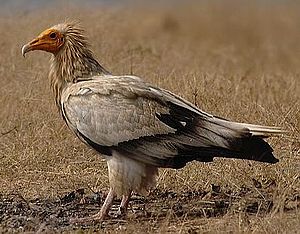

Falconiformes
The order Falconiformes is a group of about 290 species of birds that comprises the diurnal birds of prey. Raptor classification is difficult and the order is treated in several ways.- Classification problems :...
. Family: Accipitridae
Accipitridae
The Accipitridae, one of the two major families within the order Accipitriformes , are a family of small to large birds with strongly hooked bills and variable morphology based on diet. They feed on a range of prey items from insects to medium-sized mammals, with a number feeding on carrion and a...
Accipitridae is a family of birds of prey and include hawk
Hawk
The term hawk can be used in several ways:* In strict usage in Australia and Africa, to mean any of the species in the subfamily Accipitrinae, which comprises the genera Accipiter, Micronisus, Melierax, Urotriorchis and Megatriorchis. The large and widespread Accipiter genus includes goshawks,...
s, eagle
Eagle
Eagles are members of the bird family Accipitridae, and belong to several genera which are not necessarily closely related to each other. Most of the more than 60 species occur in Eurasia and Africa. Outside this area, just two species can be found in the United States and Canada, nine more in...
s, kites
Kite (bird)
Kites are raptors with long wings and weak legs which spend a great deal of time soaring. Most feed mainly on carrion but some take various amounts of live prey.They are birds of prey which, along with hawks and eagles, are from the family Accipitridae....
, harriers
Harrier (bird)
A harrier is any of the several species of diurnal hawks forming the Circinae sub-family of the Accipitridae family of birds of prey. Harriers characteristically hunt by flying low over open ground, feeding on small mammals, reptiles, or birds....
and Old World vultures. These birds have powerful hooked beaks for tearing flesh from their prey, strong legs, powerful talons, and keen eyesight. There are about 240 species worldwide and 29 species which occur in Oman.
- European Honey-buzzard Pernis apivorus
- Oriental Honey-buzzard Pernis ptilorhynchus (A)
- Black-shouldered KiteBlack-shouldered KiteThe Black-shouldered Kite or Australian Black-shouldered Kite is a small raptor found in open habitat throughout Australia and resembles similar species found in Eurasia and North America, which have in the past also been named as Black-shouldered Kites...
Elanus caeruleus (A) - Black KiteBlack KiteThe Black Kite is a medium-sized bird of prey in the family Accipitridae, which also includes many other diurnal raptors. Unlike others of the group, they are opportunistic hunters and are more likely to scavenge. They spend a lot of time soaring and gliding in thermals in search of food. Their...
Milvus migrans - Pallas's Fish-Eagle Haliaeetus leucoryphus (A)
- Egyptian VultureEgyptian VultureThe Egyptian Vulture is a small Old World vulture, found widely distributed from southwestern Europe and northern Africa to southern Asia. It is the only living member of the genus Neophron. It has sometimes also been known as the White Scavenger Vulture or Pharaoh's Chicken...
Neophron percnopterus - Eurasian Griffon Vulture Gyps fulvus
- Cinereous Vulture Aegypius monachus (A)
- Lappet-faced VultureLappet-faced VultureThe Lappet-faced Vulture or Nubian Vulture is a mostly African Old World vulture belonging to the bird order Accipitriformes, which also includes eagles, kites, buzzards and hawks. It is the only member of the genus Torgos. A distinct subspecies T. t. negevensis occurs in the Sinai, the Negev...
Torgos tracheliotus - Short-toed EagleShort-toed EagleThe Short-toed Snake Eagle also known as Short-toed Eagle, is a medium-sized bird of prey in the family Accipitridae which also includes many other diurnal raptors such as kites, buzzards and harriers.-Range and habitat:...
Circaetus gallicus - Western Marsh-Harrier Circus aeruginosus
- Northern Harrier Circus cyaneus
- Pallid HarrierPallid HarrierThe Pale or Pallid Harrier is a migratory bird of prey of the harrier family. It breeds in southern parts of eastern Europe and central Asia and winters mainly in India and southeast Asia...
Circus macrourus - Montagu's HarrierMontagu's HarrierThe Montagu's Harrier is a migratory bird of prey of the harrier family. Its common name commemorates the British naturalist George Montagu.-Plumage:...
Circus pygargus - ShikraShikraThe Shikra is a small bird of prey in the family Accipitridae found widely distributed in Asia and Africa where it is also called the Little Banded Goshawk. The African forms may represent a separate species but have usually been considered as subspecies of the Shikra...
Accipiter badius (A) - Eurasian Sparrowhawk Accipiter nisus
- Northern Goshawk Accipiter gentilis (A)
- White-eyed BuzzardWhite-eyed BuzzardThe White-eyed Buzzard is a medium sized hawk, unrelated to the true buzzards of the genus Buteo, found in South Asia. Adults are characteristic, having a rufous tail, a distinctive white iris and a white throat with a contrasting mesial stripe and bordered by dark moustachial stripes. The head is...
Butastur teesa (A) - Eurasian Buzzard Buteo buteo
- Long-legged BuzzardLong-legged BuzzardThe Long-legged Buzzard is a bird of prey.-Description:It is similar in appearance to the Rough-legged Buzzard , but larger and more robust. There are many different colour forms, but usually Long-leggeds have a clear orange tint to the plumage, red or orange tail, pale head and largely white...
Buteo rufinus - Lesser Spotted EagleLesser Spotted EagleThe Lesser Spotted Eagle is a large Eastern European bird of prey. Like all typical eagles, it belongs to the family Accipitridae...
Aquila pomarina (A) - Greater Spotted EagleGreater Spotted EagleThe Greater Spotted Eagle , occasionally just called the spotted eagle, is a large bird of prey. Like all typical eagles, it belongs to the family Accipitridae...
Aquila clanga - Tawny EagleTawny EagleThe Tawny Eagle is a large bird of prey. Like all eagles, it belongs to the family Accipitridae. It was once considered to be closely related to the migratory Steppe Eagle, Aquila nipalensis, and the two forms have previously been treated as conspecific...
Aquila rapax (A) - Steppe EagleSteppe EagleThe Steppe Eagle is a bird of prey. It is about in length and has a wingspan of . Females, weighing 2.3–4.9 kg , are slightly larger than males, at 2–3.5 kg . Like all eagles, it belongs to the family Accipitridae...
Aquila nipalensis - Eastern Imperial EagleEastern Imperial EagleThe Eastern Imperial Eagle is a large species of bird of prey that breeds from southeastern Europe to central Asia. Most populations are migratory and winter in northeastern Africa, and southern and eastern Asia. The Spanish Imperial Eagle, found in Spain and Portugal, was formerly lumped with...
Aquila heliaca - Golden EagleGolden EagleThe Golden Eagle is one of the best known birds of prey in the Northern Hemisphere. Like all eagles, it belongs to the family Accipitridae. Once widespread across the Holarctic, it has disappeared from many of the more heavily populated areas...
Aquila chrysaetos - Verreaux's EagleVerreaux's EagleVerreaux's Eagle , alternatively known as the Black Eagle , is a large bird of prey. This eagle lives in hilly and mountaineous regions of southern and eastern Africa , and very locally in Western Asia.- Description :It is long. Males weigh and females weigh...
Aquila verreauxii - Bonelli's EagleBonelli's EagleThe Bonelli's Eagle is a large bird of prey. Like all eagles, it belongs to the family Accipitridae.It breeds in southern Europe, Africa both north and south of the Sahara Desert and across southern Asia to Indonesia...
Aquila fasciatus - Booted EagleBooted EagleThe Booted Eagle is a medium-sized bird of prey. It is about in length and has a wingspan of . Like all eagles, it belongs to the family Accipitridae....
Aquila pennatus
Falcons
.jpg)
Falconiformes
The order Falconiformes is a group of about 290 species of birds that comprises the diurnal birds of prey. Raptor classification is difficult and the order is treated in several ways.- Classification problems :...
. Family: Falconidae
Falconidae
The falcons and caracaras are around 60 species of diurnal birds of prey that make up the family Falconidae. The family is divided into two subfamiles, Polyborinae, which includes the caracaras and forest falcons, and Falconinae, the falcons, kestrels and falconets.-Description:Falcons and...
Falconidae is a family of diurnal birds of prey. They differ from hawks, eagles, and kites in that they kill with their beaks instead of their feet. There are about 64 species worldwide and 10 species which occur in Oman.
- Lesser KestrelLesser KestrelThe Lesser Kestrel is a small falcon. This species breeds from the Mediterranean across southern central Asia to China and Mongolia. It is a summer migrant, wintering in Africa and Pakistan and sometimes even to India and Iraq. It is rare north of its breeding range, and declining in its European...
Falco naumanni - Eurasian Kestrel Falco tinnunculus
- Amur FalconAmur FalconThe Amur Falcon , formerly Eastern Red-footed Falcon, is a small raptor of the falcon family. It breeds in south-eastern Siberia and Northern China, wintering in Southern Africa...
Falco amurensis - Sooty FalconSooty FalconThe Sooty Falcon is a medium-sized falcon breeding from northeastern Africa to the southern Persian Gulf region. It belongs to the hobby group, a rather close-knit number of similar falcons often considered a subgenus Hypotriorchis...
Falco concolor - MerlinMerlin (bird)The Merlin is a small species of falcon from the Northern Hemisphere. A bird of prey once known colloquially as a pigeon hawk in North America, the Merlin breeds in the northern Holarctic; some migrate to subtropical and northern tropical regions in winter.-European and North American...
Falco columbarius (A) - Eurasian HobbyEurasian HobbyThe Eurasian Hobby , or just simply Hobby, is a small slim falcon. It belongs to a rather close-knit group of similar falcons often considered a subgenus Hypotriorchis.-Description:...
Falco subbuteo - Lanner FalconLanner FalconThe Lanner Falcon is a large bird of prey that breeds in Africa, southeast Europe and just into Asia. It is mainly resident, but some birds disperse more widely after the breeding season.-Description:...
Falco biarmicus - Saker FalconSaker FalconThe Saker Falcon is a very large falcon. This species breeds from eastern Europe eastwards across Asia to Manchuria. It is mainly migratory except in the southernmost parts of its range, wintering in Ethiopia, the Arabian peninsula, northern Pakistan and western China...
Falco cherrug - Barbary FalconBarbary FalconThe Barbary Falcon is a medium-sized falcon about the size of a crow. This bird of prey breeds in the Canary Islands and on the coasts of north Africa. It is mainly resident.-Description:...
Falco pelegrinoides - Peregrine FalconPeregrine FalconThe Peregrine Falcon , also known as the Peregrine, and historically as the Duck Hawk in North America, is a widespread bird of prey in the family Falconidae. A large, crow-sized falcon, it has a blue-gray back, barred white underparts, and a black head and "moustache"...
Falco peregrinus
Partridges and quails

Galliformes
Galliformes are an order of heavy-bodied ground-feeding domestic or game bird, containing turkey, grouse, chicken, New and Old World Quail, ptarmigan, partridge, pheasant, and the Cracidae. Common names are gamefowl or gamebirds, landfowl, gallinaceous birds or galliforms...
. Family: Phasianidae
Phasianidae
The Phasianidae is a family of birds which consists of the pheasants and partridges, including the junglefowl , Old World Quail, francolins, monals and peafowl. The family is a large one, and is occasionally broken up into two subfamilies, the Phasianinae, and the Perdicinae...
The Phasianidae are a family of terrestrial birds which consists of quail
Quail
Quail is a collective name for several genera of mid-sized birds generally considered in the order Galliformes. Old World quail are found in the family Phasianidae, while New World quail are found in the family Odontophoridae...
s, partridge
Partridge
Partridges are birds in the pheasant family, Phasianidae. They are a non-migratory Old World group.These are medium-sized birds, intermediate between the larger pheasants and the smaller quails. Partridges are native to Europe, Asia, Africa, and the Middle East...
s, snowcock
Snowcock
The snowcocks are a group of bird species in the genus Tetraogallus of the pheasant family, Phasianidae. They are ground-nesting birds which breed in the mountain ranges of southern Eurasia from the Caucasus to the Himalayas and western China. The Himalayan Snowcock has been introduced...
s, francolin
Francolin
Francolins are birds that traditionally have been placed in the genus Francolinus, but now commonly are divided into multiple genera , although some of the major taxonomic listing sources have yet to divide them. They are members of the pheasant family, Phasianidae...
s, spurfowls, tragopan
Tragopan
Tragopan is a genus of bird in the family Phasianidae. These birds are commonly called "horny pheasants" because of two brightly-colored, fleshy horns on their heads that they can erect during courtship displays...
s, monal
Monal
A Monal is a bird of genus Lophophorus of the Pheasant family, Phasianidae. There are three species and several sub-species within the genus Lophophorus:* Himalayan Monal Lophophorus impejanus* Sclater's Monal Lophophorus sclateri...
s, pheasant
Pheasant
Pheasants refer to some members of the Phasianinae subfamily of Phasianidae in the order Galliformes.Pheasants are characterised by strong sexual dimorphism, males being highly ornate with bright colours and adornments such as wattles and long tails. Males are usually larger than females and have...
s, peafowl
Peafowl
Peafowl are two Asiatic species of flying birds in the genus Pavo of the pheasant family, Phasianidae, best known for the male's extravagant eye-spotted tail, which it displays as part of courtship. The male is called a peacock, the female a peahen, and the offspring peachicks. The adult female...
s and jungle fowls. In general, they are plump (although they may vary in size) and have broad, relatively short wings. There are about 155 species worldwide and 6 species which occur in Oman.
- ChukarChukarThe Chukar Partridge or Chukar is a Eurasian upland gamebird in the pheasant family Phasianidae. It has been considered to form a superspecies complex along with the Rock Partridge, Philby's Partridge and Przevalski's Partridge and treated in the past as conspecific particularly with the first...
Alectoris chukar - Arabian PartridgeArabian PartridgeThe Arabian Partridge is a species of bird in the Phasianidae family.It is found in Oman, Saudi Arabia, and Yemen. Also recently introduced to Pakistan via Oman.-References:...
Alectoris melanocephala - Sand PartridgeSand PartridgeThe Sand Partridge, Ammoperdix heyi, is a gamebird in the pheasant family Phasianidae of the order Galliformes, gallinaceous birds.This partridge has its main native range from Egypt and Palestine east to south Arabia...
Ammoperdix heyi - Grey FrancolinGrey FrancolinThe Grey Francolin Francolinus pondicerianus is a species of francolin found in the plains and drier parts of South Asia...
Francolinus pondicerianus - Common QuailCommon QuailThe Common Quail, Coturnix coturnix, is a small bird in the pheasant family Phasianidae. It is widespread and is found in parts of Europe, .- Description :It is a small rotund bird, essentially streaked brown with...
Coturnix coturnix - Harlequin QuailHarlequin QuailThe Harlequin Quail is a species of bird in the Phasianidae family.It is found in Africa.-References:* BirdLife International 2004. . Downloaded on 10 July 2007....
Coturnix delegorguei (A)
Buttonquails
Order: GruiformesGruiformes
The Gruiformes are an order containing a considerable number of living and extinct bird families, with a widespread geographical diversity. Gruiform means "crane-like"....
. Family: Turnicidae
The buttonquails are small, drab, running birds which resemble the true quails.The female is the brighter of the sexes, and initiates courtship. The male incubates the eggs and tends the young. There are about 16 species worldwide and 1 species which occurs in Oman.
- Small ButtonquailSmall ButtonquailThe Kurrichane Buttonquail, Small Buttonquail, Common Buttonquail, or Andalusian Hemipode, Turnix sylvaticus, is a buttonquail, one of a small family of birds which resemble, but are unrelated to, the true quails...
Turnix sylvatica (A)
Cranes
.jpg)
Gruiformes
The Gruiformes are an order containing a considerable number of living and extinct bird families, with a widespread geographical diversity. Gruiform means "crane-like"....
. Family: Gruidae
Cranes are large, long-legged and long-necked birds. Unlike the similar-looking but unrelated herons, cranes fly with necks outstretched, not pulled back. Most have elaborate and noisy courting displays or "dances". There are about 15 species worldwide and 2 species which occur in Oman.
- Demoiselle CraneDemoiselle CraneThe Demoiselle Crane, Anthropoides virgo, is a species of crane that breeds in Central Asia and winters in India, with a few found in Cyprus and eastern Turkey as well. The crane annually migrates to Africa and South Asia in winter...
Anthropoides virgo - Common CraneCommon CraneThe Common Crane , also known as the Eurasian Crane, is a bird of the family Gruidae, the cranes.It is a large, stately bird and a medium-sized crane at 100–130 cm long, with a 180–240 cm wingspan and a weight of 4.5–6 kg...
Grus grus
Rails, crakes, gallinules, and coots
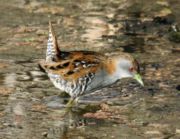
Gruiformes
The Gruiformes are an order containing a considerable number of living and extinct bird families, with a widespread geographical diversity. Gruiform means "crane-like"....
. Family: Rallidae
Rallidae
The rails, or Rallidae, are a large cosmopolitan family of small to medium-sized birds. The family exhibits considerable diversity and the family also includes the crakes, coots, and gallinules...
Rallidae is a large family of small to medium-sized birds which includes the rails, crakes, coot
Coot
Coots are medium-sized water birds that are members of the rail family Rallidae. They constitute the genus Fulica. Coots have predominantly black plumage, and, unlike many of the rails, they are usually easy to see, often swimming in open water...
s, and gallinule
Rallidae
The rails, or Rallidae, are a large cosmopolitan family of small to medium-sized birds. The family exhibits considerable diversity and the family also includes the crakes, coots, and gallinules...
s. Typically they inhabit dense vegetation in damp environments near lakes, swamps, or rivers. In general they are shy and secretive birds, difficult to observe. Most species have strong legs, and have long toes which are well adapted to soft, uneven surfaces. They tend to have short, rounded wings and be weak fliers. There are about 135 species worldwide and 13 species which occur in Oman.
- Water RailWater RailThe Water Rail is a bird of the rail family which breeds in well-vegetated wetlands across Europe, Asia and North Africa. Northern and eastern populations are migratory, but this species is a permanent resident in the warmer parts of its breeding range...
Rallus aquaticus - Corn CrakeCorn CrakeThe Corn Crake, Corncrake or Landrail is a bird in the rail family. It breeds in Europe and Asia as far east as western China, and migrates to Africa for the winter...
Crex crex - White-breasted WaterhenWhite-breasted WaterhenThe White-breasted Waterhen is a waterbird of the rail and crake family Rallidae that is widely distributed across South and Southeast Asia. They are dark slaty birds with a clean white face, breast and belly...
Amaurornis phoenicurus - Little CrakeLittle CrakeThe Little Crake is a very small waterbird of the family Rallidae.Their breeding habitat is reed beds in Europe, mainly in the east, and just into western Asia. They nest in a dry location in reed vegetation, laying 4-7 eggs...
Porzana parva - Baillon's CrakeBaillon's CrakeThe Baillon's Crake is a very small waterbird of the family Rallidae.-Distribution:Their breeding habitat is sedge beds in Europe, mainly in the east, and across Asia. They used to breed in Great Britain up to the mid-19th century, but the western European population declined through drainage....
Porzana pusilla - Spotted CrakeSpotted CrakeThe Spotted Crake is a small waterbird, of the family Rallidae.Their breeding habitat is marshes and sedge beds across temperate Europe into western Asia. They nest in a dry location in marsh vegetation, laying 6-15 eggs...
Porzana porzana - WatercockWatercockThe Watercock Gallicrex cinerea is a waterbird in the rail and crake family Rallidae. It is the only member of the genus Gallicrex....
Gallicrex cinerea (A) - Purple SwamphenPurple SwamphenThe Purple Swamphen , also known as the African Purple Swamphen, Purple Moorhen, Purple Gallinule, Pūkeko or Purple Coot, is a large bird in the family Rallidae . From its name in French, talève sultane, it is also known as the Sultana Bird...
Porphyrio porphyrio (A) - Allen's GallinuleAllen's GallinuleThe Allen's Gallinule , formerly known as the Lesser Gallinule is a small waterbird of the family Rallidae. Its former binomial name is Porphyrula alleni....
Porphyrio alleni (A) - Common MoorhenCommon MoorhenThe Common Moorhen is a bird in the Rallidae family with an almost worldwide distribution. The North and South American Committees of the AOU and the IOC have voted on or before July 2011 to split the American forms into a new species Common Gallinule, however, no other committee has voted to...
Gallinula chloropus - Lesser MoorhenLesser MoorhenThe Lesser Moorhen is a species of bird in the Rallidae family.It is found in Angola, Benin, Botswana, Burkina Faso, Burundi, Cameroon, Central African Republic, Chad, Republic of the Congo, Democratic Republic of the Congo, Ivory Coast, Egypt, Equatorial Guinea, Ethiopia, Gabon, Gambia, Ghana,...
Gallinula angulata (A) - Red-knobbed CootRed-knobbed CootThe Red-knobbed Coot or Crested Coot, , is a member of the rail and crake bird family, the Rallidae.It is a resident breeder across much of Africa and in southernmost Spain on freshwater lakes and ponds. It builds a nest of dead reeds near the water's edge or more commonly afloat, laying about 8...
Fulica cristata (A) - Eurasian CootEurasian CootThe Eurasian Coot, Fulica atra, also known as Coot, is a member of the rail and crake bird family, the Rallidae. The Australian subspecies is known as the Australian Coot.-Distribution:...
Fulica atra
Bustards
Order: GruiformesGruiformes
The Gruiformes are an order containing a considerable number of living and extinct bird families, with a widespread geographical diversity. Gruiform means "crane-like"....
. Family: Otididae
Bustards are large terrestrial birds mainly associated with dry open country and steppes in the Old World
Old World
The Old World consists of those parts of the world known to classical antiquity and the European Middle Ages. It is used in the context of, and contrast with, the "New World" ....
. They are omnivorous and nest on the ground. They walk steadily on strong legs and big toes, pecking for food as they go. They have long broad wings with "fingered" wingtips, and striking patterns in flight. Many have interesting mating displays. There are about 26 species worldwide and 2 species which occur in Oman.
- Macqueen's BustardMacqueen's BustardThe MacQueen's Bustard, Chlamydotis macqueenii, is a large bird in the bustard family. It breeds in southwestern Asia. It has recently been split as a separate species from the Houbara Bustard, Chlamydotis undulata of the Canary Islands and north Africa...
Chlamydotis macqueenii - Little BustardLittle BustardThe Little Bustard is a large bird in the bustard family, the only member of the genus Tetrax. It breeds in southern Europe and in western and central Asia. Southernmost European birds are mainly resident, but other populations migrate further south in winter...
Tetrax tetrax (A)
Jacanas
_i_img_8638.jpg)
Charadriiformes
Charadriiformes is a diverse order of small to medium-large birds. It includes about 350 species and has members in all parts of the world. Most Charadriiformes live near water and eat invertebrates or other small animals; however, some are pelagic , some occupy deserts and a few are found in thick...
. Family: Jacanidae
The jacana
Jacana
The jaçanas are a group of tropical waders in the family Jacanidae. They are found worldwide within the tropical zone. See Etymology below for pronunciation....
s are a group of tropical waders in the family Jacanidae. They are found worldwide in the Tropics. They are identifiable by their huge feet and claws which enable them to walk on floating vegetation in the shallow lakes that are their preferred habitat. There are 8 species worldwide and 1 species which occurs in Oman.
- Pheasant-tailed JacanaPheasant-tailed JacanaThe Pheasant-tailed Jacana is a jacana in the monotypic genus Hydrophasianus. Jacanas are a group of waders in the family Jacanidae that are identifiable by their huge feet and claws which enable them to walk on floating vegetation in shallow lakes, their preferred habitat...
Hydrophasianus chirurgus
Painted snipe
Order: CharadriiformesCharadriiformes
Charadriiformes is a diverse order of small to medium-large birds. It includes about 350 species and has members in all parts of the world. Most Charadriiformes live near water and eat invertebrates or other small animals; however, some are pelagic , some occupy deserts and a few are found in thick...
. Family: Rostratulidae
Painted snipe are short-legged, long-billed birds similar in shape to the true snipes, but more brightly coloured. There are 3 species worldwide and 1 species which occurs in Oman.
- Greater Painted-snipe Rostratula benghalensis (A)
Crab Plover
Order: CharadriiformesCharadriiformes
Charadriiformes is a diverse order of small to medium-large birds. It includes about 350 species and has members in all parts of the world. Most Charadriiformes live near water and eat invertebrates or other small animals; however, some are pelagic , some occupy deserts and a few are found in thick...
. Family: Dromadidae
The Crab Plover is related to the waders. It resembles a plover but with very long grey legs and a strong heavy black bill similar to a tern. It has black and white plumage, a long neck, partially webbed feet and a bill designed for eating crabs.
- Crab PloverCrab PloverThe Crab-plover or Crab Plover is a bird related to the waders, but sufficiently distinctive to merit its own family Dromadidae. Its relationship within the Charadriiformes is unclear, some have considered it to be closely related to the thick-knees, or the pratincoles, while others have...
Dromas ardeola
Oystercatchers
Order: CharadriiformesCharadriiformes
Charadriiformes is a diverse order of small to medium-large birds. It includes about 350 species and has members in all parts of the world. Most Charadriiformes live near water and eat invertebrates or other small animals; however, some are pelagic , some occupy deserts and a few are found in thick...
. Family: Haematopodidae
The oystercatcher
Oystercatcher
The oystercatchers are a group of waders; they form the family Haematopodidae, which has a single genus, Haematopus. They are found on coasts worldwide apart from the polar regions and some tropical regions of Africa and South East Asia...
s are large and noisy plover
Plover
Plovers are a widely distributed group of wading birds belonging to the subfamily Charadriinae. There are about 40 species in the subfamily, most of them called "plover" or "dotterel". The closely related lapwing subfamily, Vanellinae, comprises another 20-odd species.Plovers are found throughout...
-like birds, with strong bills used for smashing or prising open molluscs. There are about 11 species worldwide and 1 species which occurs in Oman.
- Eurasian OystercatcherEurasian OystercatcherThe Eurasian Oystercatcher Haematopus ostralegus, also known as the Common Pied Oystercatcher, or just Oystercatcher, is a wader in the oystercatcher bird family Haematopodidae. It is the most widespread of the oystercatchers, with three races breeding in western Europe, central Eurasia,...
Haematopus ostralegus
Avocets and stilts
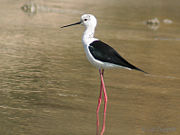
Charadriiformes
Charadriiformes is a diverse order of small to medium-large birds. It includes about 350 species and has members in all parts of the world. Most Charadriiformes live near water and eat invertebrates or other small animals; however, some are pelagic , some occupy deserts and a few are found in thick...
. Family: Recurvirostridae
Recurvirostridae
Recurvirostridae is a family of birds in the wader suborder Charadrii. It contains two distinct groups of birds, the avocets and the stilts .-Description and diet:...
Recurvirostridae is a family of large wading birds, which includes the avocet
Avocet
The four species of Avocets are a genus, Recurvirostra, of waders in the same avian family as the stilts.Avocets have long legs and long, thin, upcurved bills which they sweep from side to side when feeding in the brackish or saline wetlands they prefer...
s and the stilt
Stilt
Stilt is a common name for several species of birds in the family Recurvirostridae, which also includes those known as avocets. They are found in brackish or saline wetlands in warm or hot climates....
s. The avocets have long legs and long up-curved bills. The stilts have extremely long legs and long, thin, straight bills. There are about 9 species worldwide and 2 species which occur in Oman.
- Black-winged StiltBlack-winged StiltThe Black-winged Stilt or Common Stilt is a widely distributed very long-legged wader in the avocet and stilt family . Opinions differ as to whether the birds treated under the scientific name H. himantopus ought to be treated as a single species and if not, how many species to recognize...
Himantopus himantopus - Pied AvocetPied AvocetThe Pied Avocet, Recurvirostra avosetta, is a large black and white wader in the avocet and stilt family, Recurvirostridae. They breed in temperate Europe and western and Central Asia. It is a migratory species and most winter in Africa or southern Asia...
Recurvirostra avosetta
Thick-knees
Order: CharadriiformesCharadriiformes
Charadriiformes is a diverse order of small to medium-large birds. It includes about 350 species and has members in all parts of the world. Most Charadriiformes live near water and eat invertebrates or other small animals; however, some are pelagic , some occupy deserts and a few are found in thick...
. Family: Burhinidae
The thick-knees are a group of largely tropical waders in the family Burhinidae. They are found worldwide within the tropical zone, with some species also breeding in temperate Europe and Australia. They are medium to large waders with strong black or yellow black bills, large yellow eyes and cryptic plumage. Despite being classed as waders, most species have a preference for arid or semi-arid habitats. There are 9 species worldwide and 3 species which occur in Oman.
- Eurasian Stone-curlew Burhinus oedicnemus
- Spotted Thick-kneeSpotted Thick-kneeThe Spotted Thick-knee, Burhinus capensis, also known as the Spotted Dikkop or Cape Thick-knee, is a stone-curlew in the family Burhinidae.- Description :...
Burhinus capensis - Great Thick-kneeGreat Thick-kneeThe Great Stone-curlew or Great Thick-knee is a large wader which is a resident breeder in tropical southern Asia from India, Pakistan, Sri Lanka into South-east Asia....
Burhinus recurvirostris
Pratincoles and coursers
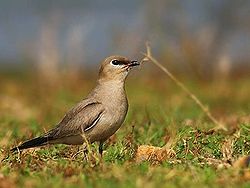
Charadriiformes
Charadriiformes is a diverse order of small to medium-large birds. It includes about 350 species and has members in all parts of the world. Most Charadriiformes live near water and eat invertebrates or other small animals; however, some are pelagic , some occupy deserts and a few are found in thick...
. Family: Glareolidae
Glareolidae
Glareolidae is a family of birds in the wader suborder Charadri. It contains two distinct groups, the pratincoles and the coursers. The coursers include the atypical Egyptian Plover, Pluvianus aegyptius, which has sometimes been placed in its own family...
Glareolidae is a family of wading birds comprising the pratincole
Pratincole
The Pratincoles or Greywaders are a group of birds which together with the coursers and Egyptian Plover make up the family Glareolidae. They have short legs, very long pointed wings and long forked tails....
s, which have short legs, long pointed wings and long forked tails, and the courser
Courser
The Coursers are a group of birds which together with the pratincoles make up the family Glareolidae. They have long legs, short wings and long pointed bills which curve downwards...
s, which have long legs, short wings and long pointed bills which curve downwards. There are 17 species worldwide and 4 species which occur in Oman.
- Cream-coloured CourserCream-coloured CourserThe Cream-colored Courser, Cursorius cursor, is a wader in the pratincole and courser family, Glareolidae.Although classed as waders, these are birds of dry open country, preferably semi-desert, where they typically hunt their insect prey by running on the ground.These coursers are found in...
Cursorius cursor - Collared PratincoleCollared PratincoleThe Collared Pratincole or Common Pratincole, Glareola pratincola, is a wader in the pratincole family, Glareolidae.Pratincoles are unusual among waders in that they typically hunt their insect prey on the wing like swallows, although they can also feed on the ground.The Collared Pratincole is a...
Glareola pratincola - Black-winged PratincoleBlack-winged PratincoleThe Black-winged Pratincole, Glareola nordmanni, is a wader in the pratincole bird family, Glareolidae.Their most unusual feature of the pratincoles is that although classed as waders they typically hunt their insect prey on the wing like swallows, although they can also feed on the...
Glareola nordmanni (A) - Small Pratincole Glareola lactea
Plovers and lapwings
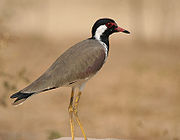
Charadriiformes
Charadriiformes is a diverse order of small to medium-large birds. It includes about 350 species and has members in all parts of the world. Most Charadriiformes live near water and eat invertebrates or other small animals; however, some are pelagic , some occupy deserts and a few are found in thick...
. Family: Charadriidae
Charadriidae
The bird family Charadriidae includes the plovers, dotterels, and lapwings, about 64 to 66 species in all.- Morphology :They are small to medium-sized birds with compact bodies, short, thick necks and long, usually pointed, wings, but most species of lapwing may have more rounded wings...
The family Charadriidae includes the plover
Plover
Plovers are a widely distributed group of wading birds belonging to the subfamily Charadriinae. There are about 40 species in the subfamily, most of them called "plover" or "dotterel". The closely related lapwing subfamily, Vanellinae, comprises another 20-odd species.Plovers are found throughout...
s, dotterels, and lapwing
Lapwing
Vanellinae are any of various crested plovers, family Charadriidae, noted for its slow, irregular wingbeat in flight and a shrill, wailing cry. Its length is 10-16 inches. They are a subfamily of medium-sized wading birds which also includes the plovers and dotterels. The Vanellinae are...
s. They are small to medium-sized birds with compact bodies, short, thick necks and long, usually pointed, wings. They are found in open country worldwide, mostly in habitats near water, although there are some exceptions. There are about 66 species worldwide and 16 species which occur in Oman.
- Northern LapwingNorthern LapwingThe Northern Lapwing , also known as the Peewit, Green Plover or just Lapwing, is a bird in the plover family. It is common through temperate Eurasia....
Vanellus vanellus - Spur-winged PloverSpur-winged PloverThe Spur-winged Lapwing or Spur-winged Plover is a lapwing species, one of a group of largish waders in the family Charadriidae....
Vanellus spinosus - Red-wattled LapwingRed-wattled LapwingThe Red-wattled Lapwing is a lapwing or large plover, a wader in the family Charadriidae. It has characteristic loud alarm calls which are variously rendered as did he do it or pity to do it leading to colloquial names like the did-he-do-it bird...
Vanellus indicus - Sociable LapwingSociable LapwingThe Sociable Lapwing or Sociable Plover is a wader in the lapwing family of birds.It breeds on open grassland in Russia and Kazakhstan. Three to five eggs are laid in a ground nest...
Vanellus gregarius - White-tailed LapwingWhite-tailed LapwingThe White-tailed Lapwing or White-tailed Plover is a wader in the lapwing genus.It breeds semi-colonially on inland marshes in Iraq, Iran and southern Russia. Four eggs are laid in a ground nest. The Iraqi and Iranian breeders are mainly residents, but Russian birds migrate south in winter to...
Vanellus leucurus - Pacific Golden-Plover Pluvialis fulva
- American Golden-Plover Pluvialis dominica (A)
- European Golden-Plover Pluvialis apricaria (A)
- Black-bellied Plover Pluvialis squatarola
- Common Ringed Plover Charadrius hiaticula
- Little Ringed PloverLittle Ringed PloverThe Little Ringed Plover is a small plover. Adults have a grey-brown back and wings, a white belly, and a white breast with one black neckband. They have a brown cap, a white forehead, a black mask around the eyes with white above and a short dark bill...
Charadrius dubius - Kentish PloverKentish PloverThe Kentish Plover, Charadrius alexandrinus, is a small wader in the plover bird family. Despite its name, this species no longer breeds in Kent, or even Great Britain...
Charadrius alexandrinus - Lesser Sandplover Charadrius mongolus
- Greater Sandplover Charadrius leschenaultii
- Caspian PloverCaspian PloverThe Caspian Plover is a wader in the plover family of birds.It breeds on open grassland in central Asia, mainly to the north and east of the Caspian Sea. This bird breeds in loose colonies, with three eggs being laid in a ground nest. These birds migrate south in winter to east Africa, usually...
Charadrius asiaticus - Eurasian DotterelEurasian DotterelThe Eurasian Dotterel , or in Europe just Dotterel, is a small wader in the plover family of birds.It breeds in the Arctic tundra of northern Eurasia, from Norway to eastern Siberia, and on suitable mountain plateaus such as the Scottish highlands and the Alps...
Charadrius morinellus (A)
Sandpipers and allies
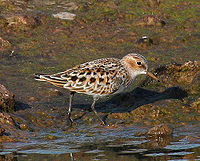
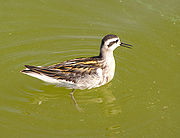
Charadriiformes
Charadriiformes is a diverse order of small to medium-large birds. It includes about 350 species and has members in all parts of the world. Most Charadriiformes live near water and eat invertebrates or other small animals; however, some are pelagic , some occupy deserts and a few are found in thick...
. Family: Scolopacidae
Scolopacidae
The sandpipers are a large family, Scolopacidae, of waders or shorebirds. They include many species called sandpipers, as well as those called by names such as curlew and snipe. The majority of these species eat small invertebrates picked out of the mud or soil...
The Scolopacidae are a large diverse family of small to medium sized shorebirds including the sandpipers, curlew
Curlew
The curlews , genus Numenius, are a group of eight species of birds, characterised by long, slender, downcurved bills and mottled brown plumage. They are one of the most ancient lineages of scolopacid waders, together with the godwits which look similar but have straight bills...
s, godwit
Godwit
The godwits are a group of large, long-billed, long-legged and strongly migratory wading birds of the genus Limosa. They form large flocks on coasts and estuaries in winter....
s, shanks
Tringa
Tringa is a genus of waders, containing the shanks and tattlers. They are mainly freshwater birds, often with brightly coloured legs as reflected in the English names of six species, as well as the specific names of two of these and the Green Sandpiper. They are typically associated with northern...
, tattler
Tattler (bird)
The tattlers are the two very similar bird species in the shorebird genus Tringa. They formerly had their own genus, Heteroscelus. The old genus name means "different leg" in Greek, referring to the leg scales that differentiate the tattlers from their close relatives, the shanks.The species are:*...
s, woodcock
Woodcock
The woodcocks are a group of seven or eight very similar living species of wading birds in the genus Scolopax. Only two woodcocks are widespread, the others being localized island endemics. Most are found in the Northern Hemisphere but a few range into Wallacea...
s, snipe
Snipe
A snipe is any of about 25 wading bird species in three genera in the family Scolopacidae. They are characterized by a very long, slender bill and crypsis plumage. The Gallinago snipes have a nearly worldwide distribution, the Lymnocryptes Jack Snipe is restricted to Asia and Europe and the...
s, dowitcher
Dowitcher
The three dowitchers are medium-sized long-billed wading birds. They resemble godwits in body and bill shape, and the reddish underparts in summer, but are much shorter legged, more like snipe to which they are also somewhat closer related...
s and phalarope
Phalarope
A phalarope or wadepiper is any of three living species of slender-necked shorebirds in the genus Phalaropus of the bird family Scolopacidae. They are close relatives of the shanks and tattlers, the Actitis and Terek Sandpipers, and also of the turnstones and calidrids...
s. The majority of species eat small invertebrates picked out of the mud or soil. Variation in length of legs and bills enable different species to feed in the same habitat, particularly on the coast, without direct competition for food. There are about 89 species worldwide and 39 species which occur in Oman.
- Eurasian WoodcockEurasian WoodcockThe Eurasian Woodcock, Scolopax rusticola, is a medium-small wading bird found in temperate and subarctic Eurasia. It has cryptic camouflage to suit its woodland habitat, with reddish-brown upperparts and buff-coloured underparts...
Scolopax rusticola (A) - Jack SnipeJack SnipeThe Jack Snipe, Lymnocryptes minimus is a small stocky wader. It is the smallest snipe, and the only member of the genus Lymnocryptes...
Lymnocryptes minimus - Pintail SnipePintail SnipeThe Pin-tailed Snipe, Gallinago stenura, also known as the Pintail Snipe, is a small stocky wader. It breeds in northern Russia and migrates to spend the non-breeding season in southern Asia from Pakistan to Indonesia. It is the most common migrant snipe in southern India, Sri Lanka and much of...
Gallinago stenura - Great SnipeGreat SnipeThe Great Snipe, Gallinago media is a small stocky wader in the genus Gallinago.This bird's breeding habitat is marshes and wet meadows with short vegetation in north-eastern Europe including north-western Russia. Great Snipes are migratory, wintering in Africa...
Gallinago media - Common SnipeCommon SnipeThe Common Snipe is a small, stocky wader native to the Old World. The breeding habitat is marshes, bogs, tundra and wet meadows throughout northern Europe and northern Asia...
Gallinago gallinago - Long-billed DowitcherLong-billed DowitcherThe Long-billed Dowitcher, Limnodromus scolopaceus, is a medium-sized shorebird.Adults have yellowish legs and a long straight dark bill. The body is dark brown on top and reddish underneath with spotted throat and breast, bars on flanks. The tail has a black and white barred pattern...
Limnodromus scolopaceus (A) - Black-tailed GodwitBlack-tailed GodwitThe Black-tailed Godwit, Limosa limosa, is a large, long-legged, long-billed shorebird first described by Carolus Linnaeus in 1758. It is a member of the Limosa genus, the godwits...
Limosa limosa - Bar-tailed GodwitBar-tailed GodwitThe Bar-tailed Godwit is a large wader in the family Scolopacidae, which breeds on Arctic coasts and tundra mainly in the Old World, and winters on coasts in temperate and tropical regions of the Old World...
Limosa lapponica - WhimbrelWhimbrelThe Whimbrel Numenius phaeopus, is a wader in the large family Scolopacidae. It is one of the mostwidespread of the curlews, breeding across much of subarctic North America, Europe and Asia as far south as Scotland....
Numenius phaeopus - Slender-billed CurlewSlender-billed CurlewThe Slender-billed Curlew, Numenius tenuirostris, is a bird in the wader family Scolopacidae. It breeds in marshes and peat bogs in the taiga of Siberia, and is migratory, formerly wintering in shallow freshwater habitats around the Mediterranean...
Numenius tenuirostris (A) - Eurasian CurlewEurasian CurlewThe Eurasian Curlew, Numenius arquata, is a wader in the large family Scolopacidae. It is one of the most widespread of the curlews, breeding across temperate Europe and Asia...
Numenius arquata - Far Eastern CurlewFar Eastern CurlewThe Far Eastern Curlew or Eastern Curlew is a large shorebird most similar in appearance to the Long-billed Curlew, but slightly larger. It is mostly brown in color, differentiated from other curlews by its plain, unpatterned brown underwing...
Numenius madagascariensis (A) - Terek SandpiperTerek SandpiperThe Terek Sandpiper is a small migratory Palearctic wader species, the only member of the genus Xenus.- Description and systematics :...
Xenus cinereus - Common SandpiperCommon SandpiperThe Common Sandpiper is a small Palearctic wader. This bird and its American sister species, the Spotted Sandpiper , make up the genus Actitis. They are parapatric and replace each other geographically; stray birds of either species may settle down with breeders of the other and hybridize...
Actitis hypoleucos - Green SandpiperGreen SandpiperThe Green Sandpiper is a small wader of the Old World. It represents an ancient lineage of the genus Tringa; its only close living relative is the Solitary Sandpiper . They both have brown wings with little light dots and a delicate but contrasting neck and chest pattern...
Tringa ochropus - Spotted RedshankSpotted RedshankThe Spotted Redshank, Tringa erythropus, is a wader in the large bird family Scolopacidae. It breeds across northern Scandinavia and northern Asia and migrates south to the Mediterranean, the southern British Isles, France, tropical Africa, and tropical Asia for the winter...
Tringa erythropus - Common Greenshank Tringa nebularia
- Lesser YellowlegsLesser YellowlegsThe Lesser Yellowlegs is a medium-sized shorebird similar in appearance to the larger Greater Yellowlegs. It is not closely related to this bird, however, but instead to the much larger and quite dissimilar Willet; merely the fine, clear and dense pattern of the neck shown in breeding plumage...
Tringa nebularia (A) - Marsh SandpiperMarsh SandpiperThe Marsh Sandpiper, Tringa stagnatilis, is a small wader. It is a rather small shank, and breeds in open grassy steppe and taiga wetlands from easternmost Europe to central Asia....
Tringa stagnatilis - Wood SandpiperWood SandpiperThe Wood Sandpiper, Tringa glareola, is a small wader. This Eurasian species is the smallest of the shanks, which are mid-sized long-legged waders of the family Scolopacidae.- Description and systematics :...
Tringa glareola - Common RedshankCommon RedshankThe Common Redshank or simply Redshank is an Eurasian wader in the large family Scolopacidae.- Description and systematics :...
Tringa totanus - Ruddy TurnstoneRuddy TurnstoneThe Ruddy Turnstone is a small wading bird, one of two species of turnstone in the genus Arenaria. It is now classified in the sandpiper family Scolopacidae but was formerly sometimes placed in the plover family Charadriidae...
Arenaria interpres - Great KnotGreat KnotThe Great Knot, Calidris tenuirostris, is a small wader. It is the largest of the calidrid species.Their breeding habitat is tundra in northeast Siberia. They nest on the ground laying about four eggs in a ground scrape. They are strongly migratory wintering on coasts in southern Asia through to...
Calidris tenuirostris - Red KnotRed KnotThe Red Knot, Calidris canutus , is a medium sized shorebird which breeds in tundra and the Arctic Cordillera in the far north of Canada, Europe, and Russia. It is a large member of the Calidris sandpipers, second only to the Great Knot...
Calidris canutus (A) - SanderlingSanderlingThe Sanderling is a small wader. It is a circumpolar Arctic breeder, and is a long-distance migrant, wintering south to South America, South Europe, Africa, and Australia...
Calidris alba - Little StintLittle StintThe Little Stint, Calidris minuta , is a very small wader. It breeds in arctic Europe and Asia, and is a long-distance migrant, wintering south to Africa and south Asia...
Calidris minuta - Temminck's StintTemminck's StintTemminck's Stint, Calidris or Erolia temminckii, is a small wader.This stint's breeding habitat is bogs and marshes in the taiga of Arctic northern Europe and Asia. It will breed in southern Scandinavia and occasionally Scotland. It has a distinctive hovering display flight. It nests in a scrape...
Calidris temminckii - Long-toed StintLong-toed StintThe Long-toed Stint, Calidris or Erolia subminuta, is a small wader bird. It breeds across northern Asia and is strongly migratory, wintering in south and south east Asia and Australasia...
Calidris subminuta - Baird's SandpiperBaird's SandpiperThe Baird's Sandpiper is a small shorebird. It is among those calidrids sometimes separated in Erolia.Adults have black legs and a short thin dark bill. They are dark brown on top and mainly white underneath with a black patch on the rump. The head and breast are light brown with dark streaks. In...
Calidris bairdii (A) - Pectoral SandpiperPectoral SandpiperThe Pectoral Sandpiper, Calidris melanotos, is a small wader. It is sometimes separated with the "stint" sandpipers in Erolia. This may or may not represent a good monophyletic group, depending on the placement of the phylogenetically enigmatic Curlew Sandpiper , the type species of Erolia...
Calidris melanotos (A) - Sharp-tailed SandpiperSharp-tailed SandpiperThe Sharp-tailed Sandpiper, Calidris acuminata is a small wader.- Taxonomy :More recently, a review of new data has indicated that this bird should perhaps better be placed into the genus Philomachus- as P...
Calidris acuminata (A) - Curlew SandpiperCurlew SandpiperThe Curlew Sandpiper is a small wader that breeds on the tundra of Arctic Siberia. It is strongly migratory, wintering mainly in Africa, but also in south and southeast Asia and in Australasia...
Calidris ferruginea - DunlinDunlinThe Dunlin, Calidris alpina, is a small wader, sometimes separated with the other "stints" in Erolia. It is a circumpolar breeder in Arctic or subarctic regions. Birds that breed in northern Europe and Asia are long-distance migrants, wintering south to Africa, southeast Asia and the Middle East...
Calidris alpina - Broad-billed SandpiperBroad-billed SandpiperThe Broad-billed Sandpiper is a small wading bird. It is the only member of the genus Limicola; some have proposed that it should be placed in the genus Erolia with the "stint" sandpipers, but more recent research suggests that it is should rather go into the genus Philomachus with the ruff and...
Limicola falcinellus - Buff-breasted SandpiperBuff-breasted SandpiperThe Buff-breasted Sandpiper, Tryngites subruficollis, is a small shorebird. It is a calidrid sandpipers and currently considered to be the only member of the genus Tryngites. Indeed, it probably belongs in the genus Calidris itself, or more precisely with the small species thereof which should be...
Tryngites subruficollis (A) - Ruff Philomachus pugnax
- Wilson's PhalaropeWilson's PhalaropeThe Wilson's Phalarope, Phalaropus tricolor, is a small wader. This bird, the largest of the phalaropes, breeds in the prairies of North America in western Canada and the western United States. It is migratory, wintering around the central Andes in South America. They are passage migrants through...
Phalaropus tricolor (A) - Red-necked PhalaropeRed-necked PhalaropeThe Red-necked Phalarope, Phalaropus lobatus, is a small wader. This phalarope breeds in the Arctic regions of North America and Eurasia. It is migratory, and, unusually for a wader, winters at sea on tropical oceans....
Phalaropus lobatus - Red PhalaropeRed PhalaropeThe Red Phalarope , Phalaropus fulicarius, is a small wader. This phalarope breeds in the Arctic regions of North America and Eurasia...
Phalaropus fulicarius
Skuas

Charadriiformes
Charadriiformes is a diverse order of small to medium-large birds. It includes about 350 species and has members in all parts of the world. Most Charadriiformes live near water and eat invertebrates or other small animals; however, some are pelagic , some occupy deserts and a few are found in thick...
. Family: Stercorariidae
The family Stercorariidae are, in general, medium to large birds, typically with grey or brown plumage, often with white markings on the wings. They nest on the ground in temperate and arctic regions and are long-distance migrants. There are about 7 species worldwide and 5 species which occur in Oman.
- South Polar SkuaSouth Polar SkuaThe South Polar Skua, Stercorarius maccormicki, is a large seabird in the skua family Stercorariidae. An older name for the bird is MacCormick’s Skua, after explorer and naval surgeon Robert McCormick, who first collected the type specimen...
Stercorarius maccormicki (A) - Brown SkuaBrown SkuaThe Brown Skua , also known as the Antarctic Skua, Southern Great Skua, Southern Skua, or Hākoakoa , is a large seabird that breeds in the subantarctic and Antarctic zones and moves further north when not breeding...
Stercorarius antarctica (A) - Pomarine SkuaPomarine SkuaThe Pomarine Skua, Stercorarius pomarinus, known as Pomarine Jaeger in North America, is a seabird in the skua family Stercorariidae. It is a migrant, wintering at sea in the tropical oceans.- Taxonomy :...
Stercorarius pomarinus - Arctic SkuaArctic SkuaThe Parasitic Jaeger, also known as the Arctic Skua or Parasitic Skua, is a seabird in the skua family Stercorariidae....
Stercorarius parasiticus - Long-tailed SkuaLong-tailed SkuaThe Long-tailed Skua, Stercorarius longicaudus is a seabird in the skua family Stercorariidae....
Stercorarius longicaudus (A)
Gulls
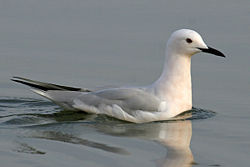
Charadriiformes
Charadriiformes is a diverse order of small to medium-large birds. It includes about 350 species and has members in all parts of the world. Most Charadriiformes live near water and eat invertebrates or other small animals; however, some are pelagic , some occupy deserts and a few are found in thick...
. Family: Laridae
Laridae is a family of medium to large birds seabirds and includes gull
Gull
Gulls are birds in the family Laridae. They are most closely related to the terns and only distantly related to auks, skimmers, and more distantly to the waders...
s and kittiwake
Kittiwake
The kittiwakes are two closely related seabird species in the gull family Laridae, the Black-legged Kittiwake and the Red-legged Kittiwake . The epithets "Black-legged" and "Red-legged" are used to distinguish the two species in North America, but in Europe, where R...
s. They are typically grey or white, often with black markings on the head or wings. They have stout, longish bills and webbed feet. There are about 56 species worldwide and 12 species which occur in Oman.
- White-eyed GullWhite-eyed GullThe White-eyed Gull is a small gull which is endemic to the Red Sea. Its closest relative is the Sooty Gull. It is one of the world's rarest gulls, with a population of just 4,000 - 6,500 pairs. The species is classed as Near Threatened by the IUCN; human pressure and oil pollution are deemed the...
Larus leucophthalmus (A) - Sooty GullSooty GullThe Sooty Gull is a species of gull in the Laridae family.It is found in Bahrain, Djibouti, Egypt, Eritrea, India, Iran, Israel, Jordan, Kenya, Lebanon, Maldives, Mozambique, Oman, Pakistan, Qatar, Saudi Arabia, Somalia, Sri Lanka, Sudan, Tanzania, United Arab Emirates, and Yemen...
Larus hemprichii - Common GullCommon GullThe Common Gull or Mew Gull Larus canus is a medium-sized gull which breeds in northern Asia, northern Europe and northwestern North America. It migrates further south in winter...
Larus canus - Lesser Black-backed GullLesser Black-backed GullThe Lesser Black-backed Gull is a large gull that breeds on the Atlantic coasts of Europe. It is migratory, wintering from the British Isles south to West Africa...
Larus fuscus - Heuglin's GullHeuglin's GullHeuglin's Gull or Siberian Gull, Larus heuglini, is a seabird in the genus Larus. It is closely related to the Lesser Black-backed Gull, Larus fuscus, and is often classified as a subspecies of it...
Larus heuglini - Caspian GullCaspian GullCaspian Gull is a name applied to the gull taxon Larus cachinnans, a member of the Herring Gull/Lesser Black-backed Gull complex.- Description :...
Larus cachinnans - Steppe Gull Larus barabensis
- Great Black-headed GullGreat Black-headed GullThe Pallas's Gull or Great Black-headed Gull, Ichthyaetus ichthyaetus, is a large gull. As is the case with many gulls, it has traditionally been placed in the genus Larus....
Larus ichthyaetus - Brown-headed GullBrown-headed GullThe Brown-headed Gull, Chroicocephalus brunnicephalus, is a small gull which breeds in the high plateaus of central Asia from Turkmenistan to Mongolia. It is migratory, wintering on the coasts and large inland lakes of tropical southern Asia...
Larus brunnicephalus (A) - Black-headed GullBlack-headed GullThe Black-headed Gull is a small gull which breeds in much of Europe and Asia, and also in coastal eastern Canada. Most of the population is migratory, wintering further south, but some birds in the milder westernmost areas of Europe are resident...
Larus ridibundus - Slender-billed GullSlender-billed GullThe Slender-billed Gull, Chroicocephalus genei, is a mid-sized gull which breeds very locally around the Mediterranean and the north of the western Indian Ocean on islands and coastal lagoons. Most of the population is somewhat migratory, wintering further south to north Africa and India, and a...
Larus genei - Black-legged KittiwakeBlack-legged KittiwakeThe Black-legged Kittiwake is a seabird species in the gull family Laridae.This species was first described by Linnaeus in his Systema naturae in 1758 as Larus tridactylus....
Rissa tridactyla (A)
Terns
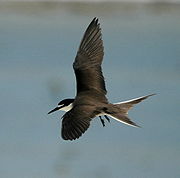
Charadriiformes
Charadriiformes is a diverse order of small to medium-large birds. It includes about 350 species and has members in all parts of the world. Most Charadriiformes live near water and eat invertebrates or other small animals; however, some are pelagic , some occupy deserts and a few are found in thick...
. Family: Sternidae
Tern
Tern
Terns are seabirds in the family Sternidae, previously considered a subfamily of the gull family Laridae . They form a lineage with the gulls and skimmers which in turn is related to skuas and auks...
s are a group of generally general medium to large sea-birds typically with grey or white plumage, often with black markings on the head. Most terns hunt fish by diving but some pick insects off the surface of fresh water. Terns are generally long-lived birds, with several species now known to live in excess of 25 to 30 years. There are about 44 species worldwide and 18 species which occur in Oman.
- Brown NoddyBrown NoddyThe Brown Noddy or Common Noddy is a seabird from the tern family. The largest of the noddies, it can be told from the closely related Black Noddy by its larger size and plumage, which is dark brown rather than black...
Anous stolidus - Lesser NoddyLesser NoddyThe Lesser Noddy , also known as the Sooty Noddy, is a species of tern in the Sternidae family.It is found in Comoros, Kenya, Liberia, Mauritius, Seychelles, South Africa, and United Arab Emirates.- References :...
Anous tenuirostris - Sooty TernSooty TernThe Sooty Tern, Onychoprion fuscatus , is a seabird of the tern family . It is a bird of the tropical oceans, breeding on islands throughout the equatorial zone. Colloquially, it is known as the Wideawake Tern or just wideawake...
Onychoprion fuscatus - Bridled TernBridled TernThe Bridled Tern is a seabird of the tern family Sternidae. It is a bird of the tropical oceans.-Description:...
Onychoprion anaethetus - Little TernLittle TernThe Little Tern, Sternula albifrons or Sterna albifrons, is a seabird of the tern family Sternidae. It was formerly placed into the genus Sterna, which now is restricted to the large white terns . The former North American and Red Sea S. a...
Sternula albifrons - Saunders's TernSaunders's TernThe Saunders's Tern is a species of tern in the Sternidae family.It is found in Bahrain, Iran, Israel, Kenya, Madagascar, Pakistan, Oman, Saudi Arabia, Tanzania, United Arab Emirates, and Yemen.-References:...
Sternula saundersi - Gull-billed TernGull-billed TernThe Gull-billed Tern formerly Sterna nilotica , is a seabird of the tern family Sternidae...
Gelochelidon nilotica - Caspian TernCaspian TernThe Caspian Tern is a species of tern, with a subcosmopolitan but scattered distribution. Despite its extensive range, it is monotypic of its genus, and has no subspecies accepted either...
Hydroprogne caspia - Black TernBlack TernThe Black Tern, Chlidonias niger, is a small tern generally found in or near inland water in Europe and North America. As its name suggests, it has predominantly dark plumage.- Description :...
Chlidonias niger (A) - White-winged TernWhite-winged TernThe White-winged Tern, or White-winged Black Tern, Chlidonias leucopterus, is a small tern generally found in or near bodies of fresh water across from Southeastern Europe east to Australia....
Chlidonias leucopterus - Whiskered TernWhiskered TernThe Whiskered Tern is a seabird of the tern family Sternidae. This bird has a number of geographical races, differing mainly in size and minor plumage details....
Chlidonias hybridus - Roseate TernRoseate TernThe Roseate Tern is a seabird of the tern family Sternidae. This bird has a number of geographical races, differing mainly in bill colour and minor plumage details....
Sterna dougallii - Arctic TernArctic TernThe Arctic Tern is a seabird of the tern family Sternidae. This bird has a circumpolar breeding distribution covering the Arctic and sub-Arctic regions of Europe, Asia, and North America...
Sterna paradisaea (A) - Common TernCommon TernThe Common Tern is a seabird of the tern family Sternidae. This bird has a circumpolar distribution, breeding in temperate and sub-Arctic regions of Europe, Asia and east and central North America. It is strongly migratory, wintering in coastal tropical and subtropical regions. It is sometimes...
Sterna hirundo - White-cheeked TernWhite-cheeked TernThe White-cheeked Tern is a species of tern in the Sternidae family.It is found in Bahrain, Djibouti, Egypt, Eritrea, India, Iran, Iraq, Israel, Jordan, Kenya, Kuwait, Maldives, Oman, Pakistan, Qatar, Saudi Arabia, Seychelles, Somalia, South Africa, Sudan, Tanzania, United Arab Emirates, and...
Sterna repressa - Great Crested Tern Thalasseus bergii
- Sandwich Tern Thalasseus sandvicensis
- Lesser Crested TernLesser Crested TernThe Lesser Crested Tern is a seabird of the tern family Sternidae...
Thalasseus bengalensis
Skimmers
Order: CharadriiformesCharadriiformes
Charadriiformes is a diverse order of small to medium-large birds. It includes about 350 species and has members in all parts of the world. Most Charadriiformes live near water and eat invertebrates or other small animals; however, some are pelagic , some occupy deserts and a few are found in thick...
. Family: Rynchopidae
Skimmer
Skimmer
The Skimmers, Rynchopidae, are a small family of tern-like birds in the order Charadriiformes, which also includes the waders, gulls and auks. The family comprises three species found in South Asia, Africa, and the Americas....
s are a small family of tropical tern-like birds. They have an elongated lower mandible which they use to feed by flying low over the water surface and skimming the water for small fish. There are 3 species worldwide and 1 species which occurs in Oman.
- Indian SkimmerIndian Skimmer (bird)The Indian Skimmer is a one of the three species that belong to the skimmer family. They are somewhat tern like but like other skimmers, have a short upper mandible and the longer lower mandible that is ploughed along the surface of water as the bird flies over the water to pick aquatic prey...
Rynchops albicollis (A)
Sandgrouse
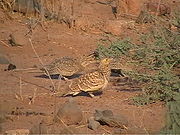
Sandgrouse have small, pigeon like heads and necks, but sturdy compact bodies. They have long pointed wings and sometimes tails and a fast direct flight. Flocks fly to watering holes at dawn and dusk. Their legs are feathered down to the toes. There are 16 species worldwide and 5 species which occur in Oman.
- Pin-tailed SandgrousePin-tailed SandgrouseThe Pin-tailed Sandgrouse is a medium large bird in the sandgrouse family.The nominate race breeds in Iberia and southern France, and the eastern form P. a. caudacutus is found in northwest Africa, and from southeast Turkey east to Kazakhstan...
Pterocles alchata (A) - Chestnut-bellied SandgrouseChestnut-bellied SandgrouseThe Chestnut-bellied Sandgrouse, Pterocles exustus, is a species of sandgrouse. They are found in sparse, bushy, arid land which is common in central and northern Africa, and southern Asia. Though they live in hot, arid climates, they are highly reliant on water. They have been known to travel up...
Pterocles exustus - Spotted SandgrouseSpotted SandgrouseThe Spotted Sandgrouse is a species of bird in the Pteroclididae family.It is found in Afghanistan, Algeria, Chad, Djibouti, Egypt, Eritrea, Ethiopia, India, Iran, Iraq, Israel, Italy, Jordan, Libya, Mali, Mauritania, Morocco, Niger, Oman, Pakistan, Saudi Arabia, Somalia, Sudan, Syria, Tunisia,...
Pterocles senegallus - Crowned SandgrouseCrowned SandgrouseThe Crowned Sandgrouse is a species of bird in the Pteroclididae family.It is found in Afghanistan, Algeria, Chad, Egypt, India, Iran, Israel, Jordan, Libya, Mali, Mauritania, Morocco, Niger, Oman, Pakistan, Saudi Arabia, Sudan, Tunisia, United Arab Emirates, Western Sahara, and...
Pterocles coronatus - Lichtenstein's SandgrouseLichtenstein's SandgrouseThe Lichtenstein's Sandgrouse is a species of bird in the Pteroclididae family, which is named after Martin Lichtenstein. They are nomadic, mostly nocturnal birds, which drink before dawn and after dusk....
Pterocles lichtensteinii
Pigeons and doves
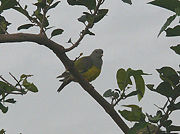
Columbiformes
Columbiformes are an avian order that includes the very widespread and successful doves and pigeons, classified in the family Columbidae, and the extinct Dodo and the Rodrigues Solitaire, long classified as a second family Raphidae. 313 species, found worldwide, comprise the Columbiformes order....
. Family: Columbidae
Pigeons and dove
Dove
Pigeons and doves constitute the bird family Columbidae within the order Columbiformes, which include some 300 species of near passerines. In general terms "dove" and "pigeon" are used somewhat interchangeably...
s are stout-bodied birds with short necks and short slender bills with a fleshy cere
Cère
The Cère is a long river in south-western France, left tributary of the Dordogne River. Its source is in the south-western Massif Central, near the mountain Plomb du Cantal...
. There are about 308 species worldwide and 11 species which occur in Oman.
- Rock Dove Columba livia
- Stock Dove Columba oenas (A)
- Common Wood-Pigeon Columba palumbus
- Eurasian Turtle-Dove Streptopelia turtur
- Oriental Turtle-Dove Streptopelia orientalis
- Eurasian Collared-Dove Streptopelia decaocto
- African Collared-Dove Streptopelia roseogrisea (A)
- Red Collared-Dove Streptopelia tranquebarica (A)
- Laughing DoveLaughing DoveThe Laughing Dove is a small pigeon which is a resident breeding bird in the tropics in Africa south of the Sahara, the Middle East and southern Asia east to India. In India it is also known as the Little Brown Dove...
Streptopelia senegalensis - Namaqua DoveNamaqua DoveThe Namaqua Dove is a small pigeon. It is the only species in the genus Oena. .-Description:The Namaqua Dove is a tiny sparrow-sized pigeon, typically 22 cm in length with a 28–33 cm wingspan, and weighing 40g. It has a very long black tapered tail, and the size and shape have led to...
Oena capensis - Bruce's Green Pigeon Treron waalia
Parrots
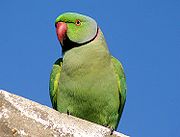
Parrot
Parrot
Parrots, also known as psittacines , are birds of the roughly 372 species in 86 genera that make up the order Psittaciformes, found in most tropical and subtropical regions. The order is subdivided into three families: the Psittacidae , the Cacatuidae and the Strigopidae...
s are small to large birds with a characteristic curved beak shape. Their upper mandibles have slight mobility in the joint with the skull and the have a generally erect stance. All parrots are zygodactyl, having the four toes on each foot placed two at the front and two back. There are about 347 species worldwide and 1 species which occurs in Oman.
- Rose-ringed ParakeetRose-ringed ParakeetThe Rose-ringed Parakeet , also known as the Ringnecked Parakeet, is a gregarious tropical parakeet species that has an extremely large range. Since the trend of the population appears to be increasing, the species has been evaluated as Least Concern by IUCN in 2009.Rose-ringed parakeets are...
Psittacula krameri (I)
Cuckoos
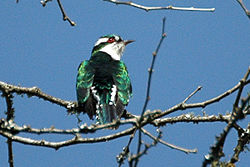
Cuculiformes
The near passerine bird order Cuculiformes traditionally included three families as below:* Musophagidae - turacos and allies* Cuculidae - cuckoos, coucals, roadrunners and anis* Opisthocomidae - Hoatzin...
. Family: Cuculidae
The family Cuculidae includes cuckoo
Cuckoo
The cuckoos are a family, Cuculidae, of near passerine birds. The order Cuculiformes, in addition to the cuckoos, also includes the turacos . Some zoologists and taxonomists have also included the unique Hoatzin in the Cuculiformes, but its taxonomy remains in dispute...
s, roadrunner
Geococcyx
The roadrunners are two species of bird in the genus Geococcyx of the cuckoo family, Cuculidae, native to North and Central America...
s and anis
Ani (bird)
The anis are the three species of near-passerine birds in the genus Crotophaga of the cuckoo family. They are essentially tropical New world birds, although the range of two species just reaches the United States...
. These birds are of variable size with slender bodies, long tails and strong legs. Unlike the cuckoo species of the Old World, North American cuckoos are not brood parasites. There are about 141 species worldwide and 7 species which occur in Oman.
- Pied CuckooPied CuckooThe Jacobin Cuckoo, Pied Cuckoo, or Pied Crested Cuckoo is a member of the cuckoo order of birds that is found in Africa and Asia. It is partially migratory and in India, it has been considered a harbinger of the Monsoon rains due to the timing of its arrival...
Clamator jacobinus - Great Spotted CuckooGreat Spotted CuckooThe Great Spotted Cuckoo is a member of the cuckoo order of birds, the Cuculiformes, which also includes the roadrunners, the anis and the coucals....
Clamator glandarius - Common Hawk-CuckooCommon Hawk-cuckooThe Common Hawk-Cuckoo , popularly known as the Brainfever bird, is a medium sized cuckoo resident in South Asia. It bears a close resemblance to the Shikra, a sparrow hawk, even in its style of flying and landing on a perch...
Cuculus varius (A) - Common CuckooCommon CuckooThe Common Cuckoo is a member of the cuckoo order of birds, Cuculiformes, which includes the roadrunners, the anis and the coucals....
Cuculus canorus - Plaintive CuckooGrey-bellied CuckooThe Grey-bellied Cuckoo or the Indian Plaintive Cuckoo, Cacomantis passerinus, is a member of the cuckoo order of birds, the Cuculiformes, which also includes the roadrunners, the anis, and the Hoatzin....
Cacomantis merulinus (A) - Dideric CuckooDideric CuckooThe Diederik Cuckoo , formerly Dideric Cuckoo or Didric Cuckoo, is a member of the cuckoo order of birds, the Cuculiformes, which also includes the roadrunners, the anis, and the Hoatzin....
Chrysococcyx caprius - Asian KoelAsian KoelThe Asian Koel is a member of the cuckoo order of birds, the Cuculiformes. It is found in South Asia, China, and Southeast Asia. It forms a superspecies with the closely related Black-billed and Pacific Koels which are sometimes treated as subspecies...
Eudynamys scolopacea
Barn owls
Order: Strigiformes. Family: TytonidaeTytonidae
Barn-owls are one of the two families of owls, the other being the true owls, Strigidae. They are medium to large sized owls with large heads and characteristic heart-shaped faces. They have long, strong legs with powerful talons...
Barn owl
Barn Owl
The Barn Owl is the most widely distributed species of owl, and one of the most widespread of all birds. It is also referred to as Common Barn Owl, to distinguish it from other species in the barn-owl family Tytonidae. These form one of two main lineages of living owls, the other being the typical...
s are medium to large sized owls with large heads and characteristic heart-shaped faces. They have long strong legs with powerful talons. There are about 16 species worldwide and 1 species which occurs in Oman.
- Barn OwlBarn OwlThe Barn Owl is the most widely distributed species of owl, and one of the most widespread of all birds. It is also referred to as Common Barn Owl, to distinguish it from other species in the barn-owl family Tytonidae. These form one of two main lineages of living owls, the other being the typical...
Tyto alba
Typical owls
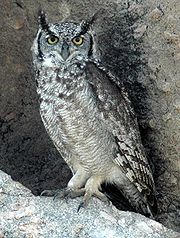
Typical owl
Typical owl
True owl or Typical owl are one of the two generally accepted families of Owls, the other being the barn owls . The Sibley-Ahlquist taxonomy unites the Caprimulgiformes with the owl order; here, the typical owls are a subfamily Strigidae...
s are small to large solitary nocturnal birds of prey. They have large forward-facing eyes and ears, a hawk-like beak, and a conspicuous circle of feathers around each eye called a facial disk. There are about 199 species worldwide and 9 species which occur in Oman.
- Pallid Scops-OwlPallid Scops-owlThe Pallid Scops Owl is a small Scops Owl ranging from the Middle East to West and Central Asia, sometimes called the Striated Scops Owl.-Description:...
Otus brucei - African Scops-Owl Otus senegalensis
- European Scops-Owl Otus scops
- Pharaoh Eagle-OwlPharaoh Eagle-owlThe Pharaoh Eagle-Owl is a species of owl in the Strigidae family.It is found in Algeria, Chad, Egypt, Eritrea, Iraq, Israel, Jordan, Kuwait, Libya, Mali, Mauritania, Morocco, Niger, Oman, Qatar, Saudi Arabia, Senegal, Sudan, Tunisia, United Arab Emirates.-References:* BirdLife International 2004....
Bubo ascalaphus - Spotted Eagle-Owl Bubo africanus
- Hume's OwlHume's OwlThe Hume’s Owl or Hume’s Tawny Owl is a species of owl. As its alternative name implies, it is closely related to the more widespread Tawny Owl....
Strix butleri - Little OwlLittle OwlThe Little Owl is a bird which is resident in much of the temperate and warmer parts of Europe, Asia east to Korea, and north Africa. It is not native to Great Britain, but was first introduced in 1842, and is now naturalised there...
Athene noctua - Long-eared OwlLong-eared OwlThe Long-eared Owl - Asio otus is a species of owl which breeds in Europe, Asia, and North America. This species is a part of the larger grouping of owls known as typical owls, family Strigidae, which contains most species of owl...
Asio otus (A) - Short-eared OwlShort-eared OwlThe Short-eared Owl is a species of typical owl . In Scotland this species of owl is often referred to as a cataface, grass owl or short-horned hootlet. Owls belonging to genus Asio are known as the eared owls, as they have tufts of feathers resembling mammalian ears. These "ear" tufts may or may...
Asio flammeus
Nightjars
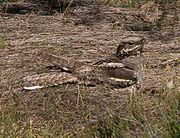
Caprimulgiformes
The Caprimulgiformes is an order of birds that includes a number of birds with global distribution . They are generally insectivorous and nocturnal...
. Family: Caprimulgidae
Nightjar
Nightjar
Nightjars are medium-sized nocturnal or crepuscular birds with long wings, short legs and very short bills. They are sometimes referred to as goatsuckers from the mistaken belief that they suck milk from goats . Some New World species are named as nighthawks...
s are medium-sized nocturnal birds with long wings, short legs and very short bills that usually nest on the ground. Most have small feet, of little use for walking, and long pointed wings. Their soft plumage is camouflaged to resemble bark or leaves. There are about 91 species worldwide and 3 species which occur in Oman.
- Eurasian Nightjar Caprimulgus europaeus
- Egyptian NightjarEgyptian NightjarThe Egyptian Nightjar, Caprimulgus aegyptius, is a medium-small nightjar which occurs in south west Asia and north Africa, and winters in tropical Africa. It is a late migrant, seldom appearing before the end of April or beginning of May...
Caprimulgus aegyptius - Nubian NightjarNubian NightjarThe Nubian Nightjar is a species of nightjar in the Caprimulgidae family. It is found in Djibouti, Egypt, Eritrea, Ethiopia, Israel, Kenya, Oman, Saudi Arabia, Somalia, Sudan, and Yemen.-References:...
Caprimulgus nubicus (A)
Swifts
Order: ApodiformesApodiformes
Traditionally, the bird order Apodiformes contained three living families: the swifts , the tree swifts , and the hummingbirds . In the Sibley-Ahlquist taxonomy, this order is raised to a superorder Apodimorphae in which hummingbirds are separated as a new order, Trochiliformes...
. Family: Apodidae
Swift
Swift
The swifts are a family, Apodidae, of highly aerial birds. They are superficially similar to swallows, but are actually not closely related to passerine species at all; swifts are in the separate order Apodiformes, which they share with hummingbirds...
s are small aerial birds, spending the majority of their lives flying. These birds have very short legs and never settle voluntarily on the ground, perching instead only on vertical surfaces. Many swifts have long swept-back wings that resemble a crescent or a boomerang. There are about 100 species worldwide and 4 species which occur in Oman.
- Alpine SwiftAlpine SwiftThe Alpine Swift syn. is a species of Swift. The bird is superficially similar to a large Barn Swallow or House Martin. It is, however, completely unrelated to those passerine species, since swifts are in the order Apodiformes...
Tachymarptis melba - Common SwiftCommon SwiftThe Common Swift is a small bird, superficially similar to the Barn Swallow or House Martin. It is, however, completely unrelated to those passerine species, since swifts are in the separate order Apodiformes...
Apus apus - Pallid SwiftPallid SwiftThe Pallid Swift is a small bird, superficially similar to a Barn Swallow or House Martin. It is, however, completely unrelated to those passerine species, since the swifts are in the order Apodiformes...
Apus pallidus - Little SwiftLittle SwiftThe Little Swift , is a small bird, superficially similar to a Barn Swallow or House Martin. It is, however, completely unrelated to those passerine species, since swifts are in the order Apodiformes. The resemblances between the groups are due to convergent evolution reflecting similar life styles...
Apus affinis
Kingfishers
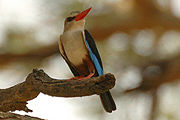
Coraciiformes
The Coraciiformes are a group of usually colorful near passerine birds including the kingfishers, the Hoopoe, the bee-eaters, the rollers, and the hornbills...
. Family: Alcedinidae
Kingfishers are medium-sized birds with large heads, long pointed bills, short legs, and stubby tails. There are about 93 species worldwide and 5 species which occur in Oman.
- Common Kingfisher Alcedo atthis
- Malachite KingfisherMalachite KingfisherThe Malachite Kingfisher is a river kingfisher which is widely distributed in Africa south of the Sahara. It is largely resident except for seasonal climate related movements....
Alcedo cristata (A) - Grey-headed KingfisherGrey-headed KingfisherThe Grey-headed Kingfisher has a wide distribution from the Cape Verde Islands off the north-west coast of Africa to Mauritania, Senegal and Gambia, east to Ethiopia, Somalia and southern Arabia and south to South Africa....
Halcyon leucocephala - Collared KingfisherCollared KingfisherThe Collared Kingfisher is a medium-sized kingfisher belonging to the family Halcyonidae, the tree kingfishers. It is also known as the White-collared Kingfisher or Mangrove Kingfisher. It has a wide range extending from the Red Sea across southern Asia and Australasia to Polynesia...
Todirhamphus chloris - Pied KingfisherPied KingfisherThe Pied Kingfisher is a water kingfisher and is found widely distributed across Africa and Asia. Their black and white plumage, crest and the habit of hovering over clear lakes and rivers before diving for fish makes it distinctive. Males have a double band across the breast while females have a...
Ceryle rudis (A)
Bee-eaters

Coraciiformes
The Coraciiformes are a group of usually colorful near passerine birds including the kingfishers, the Hoopoe, the bee-eaters, the rollers, and the hornbills...
. Family: Meropidae
The bee-eaters are a group of near passerine
Near passerine
Near passerine or higher land-bird assemblage are terms often given to arboreal birds or those most often believed to be related to the true passerines due to ecological similarities; the group corresponds to some extent with the Anomalogonatae of Garrod All near passerines are land birds...
birds in the family Meropidae. Most species are found in Africa but others occur in southern Europe, Madagascar, Australia and New Guinea. They are characterised by richly coloured plumage, slender bodies and usually elongated central tail feathers. All are colorful and have long downturned bills and pointed wings, which give them a swallow-like appearance when seen from afar. There are about 26 species worldwide and 4 species which occur in Oman.
- White-throated Bee-eaterWhite-throated Bee-eaterThe White-throated Bee-eater, Merops albicollis is a near passerine bird in the bee-eater family Meropidae. It breeds in semi-desert along the southern edge of the Sahara, Africa...
Merops albicollis (A) - Green Bee-eater Merops orientalis
- Blue-cheeked Bee-eaterBlue-cheeked Bee-eaterThe Blue-cheeked Bee-eater, Merops persicus, is a near passerine bird in the bee-eater family, Meropidae. It breeds in Northern Africa, and the Middle East from eastern Turkey to Kazakhstan and India. It is generally strongly migratory, wintering in tropical Africa, although some populations breed...
Merops persicus - European Bee-eaterEuropean Bee-eaterThe European Bee-eater, Merops apiaster, is a near passerine bird in the bee-eater family Meropidae. It breeds in southern Europe and in parts of north Africa and western Asia. It is strongly migratory, wintering in tropical Africa, India and Sri Lanka...
Merops apiaster
Typical rollers
Order: CoraciiformesCoraciiformes
The Coraciiformes are a group of usually colorful near passerine birds including the kingfishers, the Hoopoe, the bee-eaters, the rollers, and the hornbills...
. Family: Coraciidae
Rollers resemble crow
Crow
Crows form the genus Corvus in the family Corvidae. Ranging in size from the relatively small pigeon-size jackdaws to the Common Raven of the Holarctic region and Thick-billed Raven of the highlands of Ethiopia, the 40 or so members of this genus occur on all temperate continents and several...
s in size and build, but are more closely related to the kingfisher
Kingfisher
Kingfishers are a group of small to medium sized brightly coloured birds in the order Coraciiformes. They have a cosmopolitan distribution, with most species being found in the Old World and Australia...
s and bee-eater
Bee-eater
The bee-eaters are a group of near-passerine birds in the family Meropidae. Most species are found in Africa and Asia but others occur in southern Europe, Australia, and New Guinea. They are characterised by richly coloured plumage, slender bodies, and usually elongated central tail feathers...
s. They share the colourful appearance of those groups with blues and browns predominating. The two inner front toes are connected, but the outer toe is not. There are about 12 species worldwide and 3 species which occur in Oman.
- European RollerEuropean RollerThe European Roller, Coracias garrulus, is the only member of the roller family of birds to breed in Europe. Its overall range extends into the Middle East and Central Asia and Morocco....
Coracias garrulus - Lilac-breasted RollerLilac-breasted RollerThe Lilac-breasted Roller is a member of the roller family of birds. It is widely distributed in sub-Saharan Africa and the southern Arabian Peninsula, preferring open woodland and savanna; it is largely absent from treeless places...
Coracias caudata (A) - Indian RollerIndian RollerThe Indian Roller , also called the Blue Jay in former times is a member of the roller family of birds. They are found in southern Asia from Iraq to Thailand and are best known for the aerobatic displays of the male during the breeding season...
Coracias benghalensis
Hoopoes
_at_hodal_i_img_9216.jpg)
Coraciiformes
The Coraciiformes are a group of usually colorful near passerine birds including the kingfishers, the Hoopoe, the bee-eaters, the rollers, and the hornbills...
. Family: Upupidae
Hoopoes have black, white and orangey-pink colouring with a large erectile crest on their head. There are about 2 species worldwide and 1 species which occurs in Oman.
- Eurasian Hoopoe Upupa epops
Woodpeckers and allies
Order: PiciformesPiciformes
Nine families of largely arboreal birds make up the order Piciformes, the best-known of them being the Picidae, which includes the woodpeckers and close relatives...
. Family: Picidae
Picidae
The woodpeckers, piculets and wrynecks are a family, Picidae, of near-passerine birds. Members of this family are found worldwide, except for Australia and New Zealand, Madagascar, and the extreme polar regions...
Woodpeckers are small to medium sized birds with chisel like beaks, short legs, stiff tails and long tongues used for capturing insects. Some species have feet with two toes pointing forward, and two backward, while several species have only three toes. Many woodpeckers have the habit of tapping noisily on tree trunks with their beaks. There are about 219 species worldwide and 1 species which occurs in Oman.
- Eurasian WryneckEurasian WryneckThe Eurasian Wryneck, Jynx torquilla, is a species of wryneck in the family of woodpeckers.This species breeds in temperate regions of Europe and Asia. It is migratory, wintering in tropical Africa and southern Asia. It is a bird of open woodland and orchards...
Jynx torquilla
Larks
_at_sultanpur_i_picture_118.jpg)
Larks are small terrestrial birds with often extravagant songs and display flights. Most larks are fairly dull in appearance. Their food is insects and seeds. There are about 96 species worldwide and 14 species which occur in Oman.
- Singing BushlarkSinging BushlarkThe Singing Bush Lark is a species of lark found in Africa, the Middle East, and South Asia.- Range and population :The range of M. cantillans is quite extensive, with an estimated global Extent of Occurrence of 10,000,000 km2; and its global population is thought to be large, though it has...
Mirafra cantillans - Black-crowned Sparrow-LarkBlack-crowned Sparrow-larkThe Black-crowned Sparrow-lark is a species of lark in the Alaudidae family.It is found in Burkina Faso, Cape Verde, Chad, Djibouti, Egypt, Eritrea, Ethiopia, India, Iran, Iraq, Israel and Palestine, Jordan, Kuwait, Mali, Mauritania, Niger, Nigeria, Oman, Pakistan, Saudi Arabia, Senegal, Somalia,...
Eremopterix nigriceps - Bar-tailed LarkBar-tailed LarkThe Bar-tailed Lark is a species of lark in the Alaudidae family.It is found in Afghanistan, Algeria, Cape Verde, Chad, Egypt, Iran, Iraq, Israel and Palestine, Italy, Jordan, Kuwait, Lebanon, Libya, Mali, Malta, Mauritania, Morocco, Niger, Oman, Pakistan, Saudi Arabia, Sudan, Syria, Tunisia,and...
Ammomanes cincturus - Desert LarkDesert LarkThe Desert Lark, Ammomanes deserti, breeds in deserts and semi-deserts from the Sahara east through the Arabian peninsula and the Middle East to Iran, Afghanistan and Pakistan....
Ammomanes deserti - Greater Hoopoe-LarkGreater Hoopoe-larkThe Greater Hoopoe-lark or Hoopoe Lark , is a passerine bird which is a breeding resident of arid, desert and semi-desert regions from the Cape Verde Islands across much of north Africa, through the Arabian peninsula , Syria, Afghanistan, Pakistan and India...
Alaemon alaudipes - Thick-billed LarkThick-billed LarkThe Thick-billed Lark is a species of lark in the Alaudidae family. It is monotypic within the genus Rhamphocoris...
Ramphocoris clotbey (A) - Bimaculated LarkBimaculated LarkThe Bimaculated Lark, Melanocorypha bimaculata, breeds in warm temperate countries eastwards from Turkey into Central Asia. It is the eastern counterpart of its relative, the Calandra Lark....
Melanocorypha bimaculata - Greater Short-toed LarkGreater Short-toed LarkThe Greater Short-toed Lark or sometimes just Short-toed Lark is a small passerine bird. It breeds in southern Europe, northwest Africa, and across temperate Asia from Turkey and southern Russia to Mongolia. It is sometimes considered conspecific with Calandrella cinerea...
Calandrella brachydactyla - Blanford's LarkBlanford's LarkBlanford's Lark or Blanford's Short-toed Lark is a small passerine bird of the lark family, Alaudidae. It occurs in north-east Africa and Arabia. Its name commemorates the English zoologist William Thomas Blanford. It was formerly included in either the Greater Short-toed Lark or the Red-capped...
Calandrella blanfordi (A) - Lesser Short-toed LarkLesser Short-toed LarkThe Lesser Short-toed Lark is a small passerine bird. It breeds in Spain, north Africa, also including Turkey eastwards across the semi-deserts of central Asia to Mongolia and China....
Calandrella rufescens - Dunn's LarkDunn's LarkDunn's Lark is a small passerine bird of the lark family. It is a desert bird which is found across parts of the Sahara and Arabia. There are two subspecies: E. d. dunni in the Sahara and E. d. eremodites in Arabia...
Eremalauda dunni - Crested LarkCrested LarkThe Crested Lark, Galerida cristata, breeds across most of temperate Eurasia from Portugal to northeast China and eastern India, and in Africa south to Niger...
Galerida cristata - Eurasian Skylark Alauda arvensis
- Oriental SkylarkOriental SkylarkThe Oriental Skylark , also known as the Oriental Lark or Small Skylark, is a species of skylark found in South Asia and Southeast Asia...
Alauda gulgula
Swallows and martins
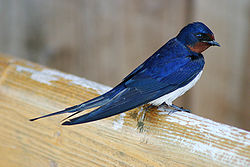
The Hirundinidae family is a group of passerines characterized by their adaptation to aerial feeding. Their adaptations include a slender streamlined body, long pointed wings and short bills with wide gape. The feet are designed for perching rather than walking, and the front toes are partially joined at the base. There are about 83 species worldwide and 11 species which occur in Oman.
- Sand MartinSand MartinThe Sand Martin is a migratory passerine bird in the swallow family. It has a wide range in summer, embracing practically the whole of Europe and the Mediterranean countries, part of northern Asia and also North America. It winters in eastern and southern Africa, South America and South Asia...
Riparia riparia - Pale Sand Martin Riparia diluta (A)
- Plain Martin Riparia paludicola
- Eurasian Crag-Martin Ptyonoprogne rupestris
- Rock Martin Ptyonoprogne fuligula
- Barn SwallowBarn SwallowThe Barn Swallow is the most widespread species of swallow in the world. It is a distinctive passerine bird with blue upperparts, a long, deeply forked tail and curved, pointed wings. It is found in Europe, Asia, Africa and the Americas...
Hirundo rustica - Wire-tailed SwallowWire-tailed SwallowThe Wire-tailed Swallow is a small passerine bird in the swallow family. Swallows are somewhat similar in habits and appearance to other aerial insectivores, such as the related martins and the unrelated swifts ....
Hirundo smithii (A) - Lesser Striped-Swallow Cecropis abyssinica (A)
- Red-rumped SwallowRed-rumped SwallowThe Red-rumped Swallow is a small passerine bird in the swallow family. It breeds in open hilly country of temperate southern Europe and Asia from Portugal and Spain to Japan, India and tropical Africa. The Indian and African birds are resident, but European and other Asian birds are migratory...
Cecropis daurica - Streak-throated SwallowStreak-throated SwallowThe Streak-throated Swallow or the Indian Cliff Swallow is a species of swallow found in South Asia....
Petrochelidon fluvicola (A) - Common House-Martin Delichon urbicum
Wagtails and pipits
_im_img_9617.jpg)
Motacillidae
The Motacillidae are a family of small passerine birds with medium to long tails. There are around 65 species in 6 genera and they include the wagtails, longclaws and pipits. The longclaws are entirely restricted to the Afrotropics, and the wagtails are predominately found in Europe, Africa and...
The Motacillidae are a family of small passerine birds with medium to long tails. They include the wagtails, longclaws and pipits. They are slender, ground feeding insectivores of open country. There are about 66 species worldwide and 16 species which occur in Oman.
- Richard's PipitRichard's PipitThe Richard's Pipit is a medium-sized passerine bird which breeds in open grasslands in northern Asia. It is a long-distance migrant moving to open lowlands in southern Asia. It is a rare but regular vagrant to western Europe...
Anthus richardi - Long-billed PipitLong-billed PipitThe Long-billed Pipit or Brown Rock Pipit is a passerine bird which has a wide distribution. A number of subspecies have been created for the populations in Africa, through the Arabian peninsula and South Asia. The systematics of this complex is yet to be clarified...
Anthus similis - Blyth's PipitBlyth's PipitThe Blyth's Pipit, Anthus godlewskii, is a medium-sized passerine bird which breeds in Mongolia and neighbouring areas. It is a long distance migrant moving to open lowlands in southern Asia. It is a very rare vagrant to western Europe....
Anthus godlewskii (A) - Tawny PipitTawny PipitThe Tawny Pipit, Anthus campestris, is a medium-large passerine bird which breeds in much of temperate Europe and Asia, and northwest Africa. It is a migrant moving in winter to tropical Africa and the Indian subcontinent....
Anthus campestris - Meadow PipitMeadow PipitThe Meadow Pipit Anthus pratensis, is a small passerine bird which breeds in much of the northern half of Europe and also northwestern Asia, from southeastern Greenland and Iceland east to just east of the Ural Mountains in Russia, and south to central France and Romania; there is also an isolated...
Anthus pratensis (A) - Red-throated PipitRed-throated PipitThe Red-throated Pipit is a small passerine bird which breeds in the far north of Europe and Asia, with a foothold in northern Alaska. It is a long-distance migrant moving in winter to Africa, south and east Asia and west coast USA...
Anthus cervinus - Olive-backed PipitOlive-backed PipitThe Olive-backed Pipit, Anthus hodgsoni, is a small passerine bird of the pipit genus, which breeds across South, north Central and East Asia, as well as in the northeast of European Russia. It is a long-distance migrant moving in winter to southern Asia and Indonesia...
Anthus hodgsoni - Tree PipitTree PipitTree Pipit, Anthus trivialis, is a small passerine bird which breeds across most of Europe and temperate western and central Asia. It is a long-distance migrant moving in winter to Africa and southern Asia....
Anthus trivialis - Water PipitWater PipitThe Water Pipit, Anthus spinoletta, is a small passerine bird which breeds in the mountains of southern Europe and southern temperate Asia across to China. It is a short-distance migrant moving to wet open lowlands such as marshes and flooded fields in winter...
Anthus spinoletta - Buff-bellied PipitBuff-bellied PipitThe Buff-bellied Pipit , or American Pipit as it is known in North America, is a small songbird found on both sides of the northern Pacific. It was first described by Marmaduke Tunstall in his 1771 Ornithologia Britannica...
Anthus rubescens (A) - Golden PipitGolden PipitThe Golden Pipit is a distinctive pipit of dry country grassland, savanna and shrubland in eastern Africa. It is native to Ethiopia, Kenya, Somalia, Sudan, Tanzania and Uganda, and has occurred as a vagrant to Oman, South Africa and Zimbabwe.The adult male, unlike most pipits, is very easy to...
Tmetothylacus tenellus (A) - Forest WagtailForest WagtailThe Forest Wagtail is a medium-sized passerine bird in the wagtail family Motacillidae. It has a distinctive plumage that sets it apart from other wagtails and has the habit of wagging its tail sideways unlike the usual up and down movements of the other wagtail species. It is the only wagtail...
Dendronanthus indicus (A) - White WagtailWhite Wagtail"Pied Wagtail" redirects here. For the related African bird, see African Pied Wagtail.The White Wagtail is a small passerine bird in the wagtail family Motacillidae, which also includes the pipits and longclaws. This species breeds in much of Europe and Asia and parts of north Africa...
Motacilla alba - Yellow Wagtail Motacilla flava
- Citrine WagtailCitrine WagtailThe Citrine Wagtail or Yellow-headed Wagtail is a small songbird in the family Motacillidae. The term citrine refers to its yellowish colouration. Its systematics, phylogeny and taxonomy are subject of considerable debate in the early 21st century. This is because this bird forms a cryptic...
Motacilla citreola - Grey WagtailGrey WagtailThe Grey Wagtail is a small member of the wagtail family, Motacillidae. The species looks similar to the Yellow Wagtail but has the yellow on its underside restricted to the throat and vent. Breeding males have a black throat...
Motacilla cinerea
Bulbuls
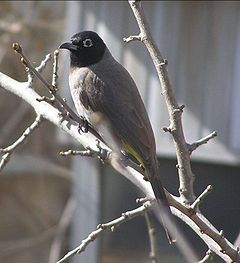
Bulbuls are medium-sized songbirds. Some are colourful with yellow, red or orange vents, cheeks, throat or supercilia, but most are drab, with uniform olive brown to black plumage. Some species have distinct crests.There are about 130 species worldwide and 3 species which occur in Oman.
- White-spectacled BulbulWhite-spectacled BulbulThe White-spectacled Bulbul also known as the Yellow-vented Bulbul, Pycnonotus xanthopygos, is a small bird, a bit bigger than a sparrow. It is 19–21 centimeters in length, and its wingspan is 20–25 centimeters. A stable bird that lives in fruit plantations, gardens, cities etc. It is the most...
Pycnonotus xanthopygos - White-eared BulbulWhite-eared BulbulThe White-eared Bulbul, Pycnonotus leucotis is a member of the bulbul family. It is found in Kuwait, Bahrain, mid and southern Iraq, southern Iran, Afghanistan, Pakistan, north-western India, in parts of Maharashtra, Madhya Pradesh, and on the Arabian peninsula...
Pycnonotus leucotis - Red-vented BulbulRed-vented BulbulThe Red-vented Bulbul is a member of the bulbul family of passerine birds. It is resident breeder in tropical southern Asia from India and Sri Lanka east to Burma and southwestern China. It has been introduced and has established itself in the wild in many Pacific islands including Fiji, Samoa,...
Pycnonotus cafer (I)
Grey Hypocolius

The Grey Hypocolius is a small Middle Eastern bird. They are mainly a uniform grey color, with males having a black triangular mask around the eyes, and with the shape and soft plumage of the waxwings.
- HypocoliusHypocoliusThe Grey Hypocolius or simply Hypocolius is a small passerine bird species. It is the sole member of the genus Hypocolius and it is placed in a family of its own, the Hypocoliidae. This slender and long tailed bird is found in the dry semi-desert region of northern Africa, Arabia, Afghanistan,...
Hypocolius ampelinus
Accentors
Order: Passeriformes. Family: PrunellidaeThe accentors are in the only bird family, Prunellidae, which is completely endemic to the Palearctic
Palearctic
The Palearctic or Palaearctic is one of the eight ecozones dividing the Earth's surface.Physically, the Palearctic is the largest ecozone...
. They are small, fairly drab species superficially similar to sparrow
Sparrow
The sparrows are a family of small passerine birds, Passeridae. They are also known as true sparrows, or Old World sparrows, names also used for a genus of the family, Passer...
s. There are 13 species worldwide and 2 species which occur in Oman.
- Radde's AccentorRadde's AccentorThe Radde's Accentor is a species of bird in the Prunellidae family. It is found in Armenia, Azerbaijan, Georgia, India, Iran, Iraq, Israel, Jordan, Lebanon, Pakistan, Russia, Syria, and Turkey....
Prunella ocularis (A) - Black-throated AccentorBlack-throated AccentorThe Black-throated Accentor , Prunella atrogularis, is a small passerine bird found across temperate and subarctic Asia. It is migratory, wintering in India and other parts of southern Asia. It is a rare vagrant in western Europe....
Prunella atrogularis (A)
Thrushes
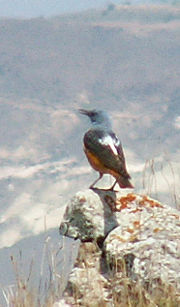
The thrushes
Thrush (bird)
The thrushes, family Turdidae, are a group of passerine birds that occur worldwide.-Characteristics:Thrushes are plump, soft-plumaged, small to medium-sized birds, inhabiting wooded areas, and often feed on the ground or eat small fruit. The smallest thrush may be the Forest Rock-thrush, at and...
are a group of passerine birds that occur mainly in the Old World. They are plump, soft plumaged, small to medium-sized insectivores or sometimes omnivores, often feeding on the ground. Many have attractive songs. There are about 176 species worldwide and 9 species which occur in Oman.
- Rufous-tailed Rock-Thrush Monticola saxatilis
- Blue Rock-Thrush Monticola solitarius
- Scaly Thrush Zoothera dauma (A)
- Ring OuzelRing OuzelThe Ring Ouzel is a European member of the thrush family Turdidae.It is the mountain equivalent of the closely related Common Blackbird, and breeds in gullies, rocky areas or scree slopes....
Turdus torquatus (A) - Eyebrowed ThrushEyebrowed ThrushThe Eyebrowed Thrush, Turdus obscurus, is a member of the thrush family Turdidae.It breeds in dense coniferous forest and taiga eastwards from Siberia. It is strongly migratory, wintering south to southeast Asia and Indonesia. It is a rare vagrant to western Europe.It nests in trees, laying 4-6...
Turdus obscurus (A) - Dark-throated ThrushDark-throated ThrushThe Dark-throated Thrush is a passerine bird in the thrush family. It has two races: T. r. atrogularis, the Black-throated Thrush, and T. r. ruficollis, the Red-throated Thrush. These are sometimes considered different species...
Turdus ruficollis - Dusky ThrushDusky ThrushThe Dusky Thrush, Turdus eunomus, is a member of the thrush family Turdidae which breeds eastwards from central Siberia. It is closely related to the more southerly breeding Naumann's Thrush T...
Turdus naumanni (A) - Song ThrushSong ThrushThe Song Thrush is a thrush that breeds across much of Eurasia. It is also known in English dialects as throstle or mavis. It has brown upperparts and black-spotted cream or buff underparts and has three recognised subspecies...
Turdus philomelos - Mistle ThrushMistle ThrushThe Mistle Thrush is a member of the thrush family Turdidae.It is found in open woods and cultivated land over all of Europe and much of Asia...
Turdus viscivorus (A)
Cisticolas and allies
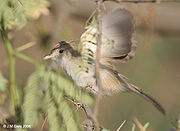
Cisticolidae
The Cisticolidae family of small passerine birds is a group of about 110 warblers found mainly in warmer southern regions of the Old World. They are often included within the Old World warbler family Sylviidae....
The Cisticolidae are warblers found mainly in warmer southern regions of the Old World. They are generally very small birds of drab brown or grey appearance found in open country such as grassland or scrub. There are about 111 species worldwide and 3 species which occur in Oman.
- Zitting CisticolaZitting CisticolaThe Zitting Cisticola or Streaked Fantail Warbler , is widely distributed Old World warbler whose breeding range includes southern Europe, Africa outside the deserts and rainforest, and southern Asia down to northern Australia...
Cisticola juncidis (A) - Streaked Scrub-WarblerStreaked Scrub-warblerThe Streaked Scrub-warbler is a species of bird in the Cisticolidae family.It is found in Afghanistan, Algeria, Egypt, India, Iran, Israel, Jordan, Kazakhstan, Lebanon, Libya, Mauritania, Morocco, Oman, Pakistan, Palestine, Russia, Saudi Arabia, Syria, Tajikistan, Tunisia, Turkmenistan, United...
Scotocerca inquieta - Graceful PriniaGraceful PriniaThe Graceful Prinia, Prinia gracilis, is a small warbler . This prinia is a resident breeder in Northeast Africa and Southwest Asia, from Egypt and Somalia east to Pakistan and North India, where it is sometimes called Streaked Wren-Warbler.This active passerine bird is typically found in shrub or...
Prinia gracilis
Old World warblers
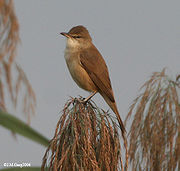

Sylviidae
Sylviidae is a family of passerine birds that was part of an assemblage known as the Old World warblers. The family was formerly a wastebin taxon with over 400 species of bird in over 70 genera. The family was poorly defined with many characteristics shared with other families...
The family Sylviidae is a group of small insectivorous passerine birds. The Sylviidae mainly occur as breeding species, as the common name implies, in Europe, Asia and, to a lesser extent Africa. Most are of generally undistinguished appearance, but many have distinctive songs. There are about 291 species worldwide and 40 species which occur in Oman.
- Grasshopper WarblerGrasshopper WarblerThe Grasshopper Warbler, Locustella naevia, is an Old World warbler in the grass warbler genus Locustella. It breeds across much of temperate Europe and Asia. It is migratory, wintering from northwest Africa to India....
Locustella naevia - Eurasian River Warbler Locustella fluviatilis (A)
- Savi's WarblerSavi's WarblerThe Savi's Warbler, Locustella luscinioides, is an Old World warbler in the grass warbler genus Locustella. It breeds in southern Europe into temperate western Asia. It is migratory, wintering in sub-Saharan Africa....
Locustella luscinioides (A) - Moustached WarblerMoustached WarblerThe Moustached Warbler, Acrocephalus melanopogon, is an Old World warbler in the genus Acrocephalus. It breeds in southern Europe and southern temperate Asia with a few in north-west Africa. It is partially migratory...
Acrocephalus melanopogon (A) - Sedge WarblerSedge WarblerThe Sedge Warbler is an Old World warbler in the genus Acrocephalus. It is a medium-sized warbler with a brown, streaked back and wings and a distinct pale supercilium. Sedge Warblers are migratory, crossing the Sahara to get from their European and Asian breeding grounds to spend winter in Africa...
Acrocephalus schoenobaenus - Paddyfield WarblerPaddyfield WarblerThe Paddyfield Warbler, Acrocephalus agricola, is a species of marsh-warbler . It was formerly included in the "Old World warbler" assemblage. The Manchurian Reed-warbler was included in A. agricola as a subspecies.It breeds in temperate central Asia. It is migratory, wintering in Pakistan and...
Acrocephalus agricola (A) - Eurasian Reed-Warbler Acrocephalus scirpaceus
- Blyth's Reed-Warbler Acrocephalus dumetorum (A)
- Marsh WarblerMarsh WarblerThe Marsh Warbler, Acrocephalus palustris, is an Old World warbler currently classified in the family Acrocephalidae. It breeds in temperate Europe and western Asia and winters mainly in south east Africa...
Acrocephalus palustris - Great Reed-Warbler Acrocephalus arundinaceus
- Clamorous Reed-WarblerClamorous Reed-WarblerThe Clamorous Reed Warbler is an Old World warbler in the genus Acrocephalus. It breeds from Egypt eastwards through Pakistan, Afghanistan and northernmost India to south China, southeast Asia and south to Australia...
Acrocephalus stentoreus - Thick-billed WarblerThick-billed WarblerThe Thick-billed Warbler is an Old World warbler that breeds in temperate east Asia. It is migratory, wintering in tropical south east Asia. It is a very rare vagrant to western Europe....
Acrocephalus aedon (A) - Booted WarblerBooted WarblerThe Booted Warbler is an Old World warbler in the tree warbler group. It was formerly considered to be conspecific with Sykes' Warbler, but the two are now usually both afforded species status...
Hippolais caligata - Sykes's Warbler Hippolais rama
- Eastern Olivaceous WarblerEastern Olivaceous WarblerThe Eastern Olivaceous Warbler is a "warbler", formerly placed in the Old World warblers when these were a paraphyletic wastebin taxon. It is now considered a member of the acrocephaline warbelrs, Acrocephalidae, in the tree warbler genus Hippolais ...
Hippolais pallida - Upcher's WarblerUpcher's WarblerThe Upcher's Warbler, , is an Old World warbler in the tree warbler genus Hippolais. It breeds in an area from Turkey south and east to Pakistan...
Hippolais languida - Olive-tree WarblerOlive-tree WarblerThe Olive-tree Warbler is an Old World warbler in the tree warbler genus Hippolais. It breeds in southeast Europe and the near east. It is migratory, wintering in eastern and southern Africa, from Kenya south to South Africa.This small passerine bird is a species found in open-canopy oakwoods,...
Hippolais olivetorum (A) - Icterine WarblerIcterine WarblerThe Icterine Warbler is an Old World warbler in the tree warbler genus Hippolais . It breeds in mainland Europe except the southwest, where it is replaced by its western counterpart, Melodious Warbler. It is migratory, wintering in sub-Saharan Africa...
Hippolais icterina (A) - Willow WarblerWillow WarblerThe Willow Warbler is a very common and widespread leaf warbler which breeds throughout northern and temperate Europe and Asia, from Ireland east to the Anadyr River basin in eastern Siberia...
Phylloscopus trochilus - Common Chiffchaff Phylloscopus collybita
- Plain Leaf-WarblerPlain Leaf-warblerThe Plain Leaf-Warbler is a species of Old World warbler in the Phylloscopidae family.It is found in Afghanistan, Bahrain, India, Iran, Oman, Pakistan, Russia, Tajikistan, Turkmenistan, United Arab Emirates, and Uzbekistan....
Phylloscopus neglectus - Eastern Bonelli's WarblerEastern Bonelli's WarblerEastern Bonelli's Warbler is a "warbler" in the leaf warbler genus Phylloscopus. It was formerly regarded as the eastern subspecies of a wider "Bonelli's Warbler" species, but as a result of modern taxonomic developments, this species is now usually considered to be two species :* Western Bonelli's...
Phylloscopus orientalis (A) - Wood WarblerWood WarblerThe Wood Warbler is a common and widespread leaf warbler which breeds throughout northern and temperate Europe, and just into the extreme west of Asia in the southern Ural Mountains...
Phylloscopus sibilatrix - Yellow-browed WarblerYellow-browed WarblerThe Yellow-browed Warbler is a leaf warbler which breeds in temperate Asia. This warbler is strongly migratory and winters mainly in tropical southeast Asia, but also in small numbers in western Europe...
Phylloscopus inornatus (A) - Hume's Warbler Phylloscopus humei (A)
- Arctic WarblerArctic WarblerThe Arctic Warbler, Phylloscopus borealis, is a widespread leaf warbler in birch or mixed birch forest near water throughout its breeding range in Fennoscandia and northern Asia. It has established a foothold in North America, breeding in Alaska. This warbler is strongly migratory; the entire...
Phylloscopus borealis (A) - Greenish WarblerGreenish WarblerThe Greenish Warbler and Green Warbler are widespread leaf-warblers throughout their breeding range in northeastern Europe and temperate to subtropical continental Asia. This warbler is strongly migratory and winters in India. It is not uncommon as a spring or early autumn vagrant in Western...
Phylloscopus trochiloides (A)- Green Warbler Phylloscopus (trochiloides) nitidus
- BlackcapBlackcapThe Blackcap is a common and widespread sylviid warbler which breeds throughout temperate Europe, western Asia and northwestern Africa, and winters from northwestern Europe south to tropical Africa...
Sylvia atricapilla - Garden WarblerGarden WarblerThe Garden Warbler, Sylvia borin, is a common and widespread typical warbler which breeds throughout northern and temperate Europe into western Asia. This small passerine bird is strongly migratory, and winters in central and southern Africa...
Sylvia borin - Greater Whitethroat Sylvia communis
- Lesser WhitethroatLesser WhitethroatThe Lesser Whitethroat is a common and widespread typical warbler which breeds in temperate Europe, except the southwest, and in western and central Asia. This small passerine bird is strongly migratory, wintering in Africa just south of the Sahara, Arabia and India.Unlike many typical warblers,...
Sylvia curruca - Small WhitethroatSmall WhitethroatThe Desert Whitethroat is a typical warbler. Until recently, it was considered conspecific with the Lesser Whitethroat; today these are seen as members of a superspecies...
Sylvia minula - Hume's WhitethroatHume's WhitethroatHume's Whitethroat Sylvia althaea is a species of typical warbler. Until recently, it was considered conspecific with the Lesser Whitethroat; today these are seen as members of a superspecies which also includes the Desert Whitethroat...
Sylvia althaea (A) - Asian Desert WarblerAsian Desert WarblerThe Asian Desert Warbler Sylvia nana is a typical warbler which breeds in the deserts of central and western Asia and the extreme east of Europe , and migrating to similar habitats in southwestern Asia and the far northeast of Africa in winter...
Sylvia nana - Barred WarblerBarred WarblerThe Barred Warbler is a typical warbler which breeds across temperate regions of central and eastern Europe and western and central Asia. This passerine bird is strongly migratory, and winters in tropical eastern Africa....
Sylvia nisoria - Eastern Orphean WarblerEastern Orphean WarblerThe Eastern Orphean Warbler, Sylvia hortensis crassirostris, is a typical warbler of the genus Sylvia. This species occurs in summer around the Mediterranean, through the Balkans via Turkey, the Caucasus and surrounding regions to Central Asia. It is migratory, wintering in sub-Saharan Africa...
Sylvia crassirostris - Red Sea WarblerRed Sea WarblerThe Arabian Warbler or Red Sea Warbler is a species of Old World warbler in the Sylviidae family.It is found in Djibouti, Egypt, Eritrea, Israel, Jordan, Oman, Saudi Arabia, Somalia, Sudan, and Yemen....
Sylvia leucomelaena - Menetries's WarblerMenetries's WarblerMenetries's Warbler or Ménétries's Warbler is a small passerine bird of south-west Asia belonging to the genus Sylvia. The name of the species commemorates Édouard Ménétries, the French zoologist who described the species in 1832...
Sylvia mystacea - Sardinian WarblerSardinian WarblerThe Sardinian Warbler, Sylvia melanocephala, is a common and widespread typical warbler from the Mediterranean region.-Description:...
Sylvia melanocephala (A)
Old World flycatchers and chats
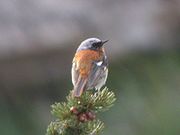

Old World flycatchers are a large group of small passerine birds native to the Old World. They are mainly small arboreal insectivores. The appearance of these birds is very varied, but they mostly have weak songs and harsh calls. There are about 275 species worldwide and 34 species which occur in Oman.
- Spotted FlycatcherSpotted FlycatcherThe Spotted Flycatcher, Muscicapa striata, is a small passerine bird in the Old World flycatcher family. It breeds in most of Europe and western Asia, and is migratory, wintering in Africa and south western Asia. It is declining in parts of its range....
Muscicapa striata - Asian Brown FlycatcherAsian Brown FlycatcherThe Asian Brown Flycatcher, Muscicapa dauurica, is a small passerine bird in the flycatcher family Muscicapidae. It includes the Brown-streaked Flycatcher, which is sometimes considered a distinct species Muscicapa williamsoni....
Muscicapa dauurica (A) - European Pied FlycatcherEuropean Pied FlycatcherThe Pied Flycatcher, Ficedula hypoleuca, is a small passerine bird in the Old World flycatcher family, one of the four species of Western Palearctic black-and-white flycatchers. It breeds in most of Europe and western Asia. It is migratory, wintering mainly in western Africa. It hybridizes with...
Ficedula hypoleuca (A) - Semicollared Flycatcher Ficedula semitorquata
- Red-breasted FlycatcherRed-breasted FlycatcherThe Red-breasted Flycatcher is a small passerine bird in the Old World flycatcher family. It breeds in eastern Europe and across central Asia and is migratory, wintering in south Asia. It is a regular passage migrant in western Europe, whereas the Collared Flycatcher which breeds further west is...
Ficedula parva - Blue-and-white FlycatcherBlue-and-White FlycatcherThe Blue-and-white Flycatcher, Cyanoptila cyanomelana is a migratory songbird. It breeds in Japan, Korea, and in parts of China and Russia. It winters in South East Asia, especially in Vietnam, Cambodia, Thailand, Sumatra and Borneo.-References:...
Cyanoptila cyanomelana (A) - European RobinEuropean RobinThe European Robin , most commonly known in Anglophone Europe simply as the Robin, is a small insectivorous passerine bird that was formerly classed as a member of the thrush family , but is now considered to be an Old World flycatcher...
Erithacus rubecula (A) - Thrush NightingaleThrush NightingaleThe Thrush Nightingale, Luscinia luscinia , is a small passerine bird that was formerly classed as a member of the thrush family Turdidae, but is now more generally considered to be an Old World flycatcher, Muscicapidae...
Luscinia luscinia (A) - Common Nightingale Luscinia megarhynchos
- BluethroatBluethroatThe Bluethroat is a small passerine bird that was formerly classed as a member of the thrush family Turdidae, but is now more generally considered to be an Old World flycatcher, Muscicapidae...
Luscinia svecica - White-throated RobinWhite-throated RobinThe White-throated Robin is a small passerine bird that was formerly classed as a member of the thrush family Turdidae, but is now more generally considered to be an Old World flycatcher, family Muscicapidae...
Irania gutturalis - Rufous-tailed Scrub-Robin Cercotrichas galactotes
- Black Scrub-RobinBlack Scrub-robinThe Black Scrub-robin is a species of bird in the Muscicapidae family.It is found in Bahrain, Burkina Faso, Cameroon, Chad, Djibouti, Egypt, Eritrea, Ethiopia, Guinea-Bissau, Israel, Jordan, Mali, Mauritania, Niger, Nigeria, Oman, Saudi Arabia, Senegal, Somalia, Sudan, United Arab Emirates, and...
Cercotrichas podobe (A) - Rufous-backed RedstartRufous-backed RedstartEversmann's Redstart or Rufous-backed Redstart is a passerine bird belonging to the genus Phoenicurus, a genus of redstarts. It was formerly classified in the thrush family Turdidae but is now placed in the Old World flycatcher family Muscicapidae...
Phoenicurus erythronota - Black RedstartBlack RedstartThe Black Redstart Phoenicurus ochruros is a small passerine bird in the redstart genus Phoenicurus. Like its relatives, it was formerly classed as a member of the Thrush family , but is now known to be an Old World flycatcher .-Description:The Black Redstart is 13–14.5 cm in length and 12–20...
Phoenicurus ochruros - Common RedstartCommon RedstartThe Common Redstart , or often simply Redstart, is a small passerine bird in the redstart genus Phoenicurus...
Phoenicurus phoenicurus - Siberian StonechatSiberian StonechatThe Siberian Stonechat or Asian Stonechat is a recently-validated species of the Old World flycatcher family . Like the other thrush-like flycatchers, it was often placed in the Turdidae in the past...
Saxicola maurus - WhinchatWhinchatThe Whinchat Saxicola rubetra is a small migratory passerine bird breeding in Europe and western Asia and wintering in Africa.Its scientific name means "small rock-dweller", in reference to its habitat...
Saxicola rubetra - Pied BushchatPied BushchatThe Pied Bushchat is a small passerine bird found ranging from West and Central Asia to South and Southeast Asia. About sixteen subspecies are recognized through its wide range with many island forms...
Saxicola caprata (A) - White-tailed Wheatear Oenanthe leucopyga (A)
- Hooded WheatearHooded WheatearThe Hooded Wheatear, Oenanthe monacha, is a wheatear, a small insectivorous passerine that was formerly classed as a member of the Thrush family Turdidae, but is now more generally considered to be an Old World flycatcher, Muscicapidae....
Oenanthe monacha - Hume's WheatearHume's WheatearThe Hume's Wheatear is a species of bird in the Muscicapidae family.It is found in Afghanistan, Bahrain, India, Iran, Iraq, Kuwait, Oman, Pakistan, Qatar, and United Arab Emirates.-References:...
Oenanthe alboniger - Northern WheatearNorthern WheatearThe Northern Wheatear or Wheatear is a small passerine bird that was formerly classed as a member of the thrush family Turdidae, but is now more generally considered to be an Old World flycatcher, Muscicapidae...
Oenanthe oenanthe - Mourning WheatearMourning WheatearThe Mourning Wheatear is a bird, one of 14 species of wheatear found in the Palearctic region. It is a small passerine in a group formerly classed as members of the Thrush family Turdidae, but now more generally considered to be part of the Old World Flycatcher family Muscicapidae.The Mourning...
Oenanthe lugens (A) - Arabian WheatearArabian WheatearThe Arabian Wheatear is a species of bird in the Muscicapidae family. It is found in Oman, Palestine, Saudi Arabia, and Yemen.-References:* BirdLife International 2004. . Downloaded on 26 July 2007....
Oenanthe lugentoides - Finsch's WheatearFinsch's WheatearThe Finsch's Wheatear, Oenanthe finschii , is a wheatear, a small insectivorous passerine that was formerly classed as a member of the Thrush family Turdidae, but is now more generally considered to be an Old World flycatcher, Muscicapidae....
Oenanthe finschii (A) - Variable WheatearVariable WheatearThe Variable Wheatear is a species of bird in the Muscicapidae family. It is found in Afghanistan, Egypt, India, Iran, Kazakhstan, Lebanon, Nepal, Oman, Pakistan, Russia, State of Israel, Tajikistan, Turkmenistan, United Arab Emirates, and Uzbekistan.Its natural habitat is hot...
Oenanthe picata - Pied WheatearPied WheatearThe Pied Wheatear, Oenanthe pleschanka, is a wheatear, a small insectivorous passerine that was formerly classed as a member of the Thrush family Turdidae, but is now more generally considered to be an Old World flycatcher, Muscicapidae....
Oenanthe pleschanka - Cyprus WheatearCyprus WheatearThe Cyprus Wheatear or Cyprus Pied Wheatear is a small, 14–15 cm long passerine bird that was formerly classed as a member of the thrush family Turdidae, but is now more generally considered to be an Old World flycatcher, Muscicapidae...
Oenanthe cypriaca (A) - Black-eared WheatearBlack-eared WheatearThe Black-eared Wheatear is a wheatear, a small migratory passerine bird that was formerly classed as a member of the Thrush family Turdidae, but is now more generally considered to be an Old World flycatcher, Muscicapidae....
Oenanthe hispanica (A) - Red-tailed WheatearRed-tailed WheatearThe Red-tailed Wheatear , also known as the Rusty-tailed Wheatear, Persian Wheatear or Afghan Wheatear, is a small passerine bird breeding in mountainous areas of south-west and central Asia...
Oenanthe xanthoprymna - Desert WheatearDesert WheatearThe Desert Wheatear is a wheatear, a small passerine bird that was formerly classed as a member of the Thrush family Turdidae, but is now more generally considered to be an Old World flycatcher, Muscicapidae....
Oenanthe deserti - Isabelline WheatearIsabelline WheatearThe Isabelline Wheatear, Oenanthe isabellina, is a small passerine bird that was formerly classed as a member of the Thrush family Turdidae, but is now more generally considered to be an Old World flycatcher, Muscicapidae....
Oenanthe isabellina - BlackstartBlackstartThe Blackstart, Cercomela melanura, is a chat found in desert regions in North Africa, the Middle East and the Arabian Peninsula.It is a 14–16 cm long bird named for its black tail, which is frequently fanned; the rest of its plumage is bluish-grey or grey-brown...
Cercomela melanura
Monarch flycatchers
Order: Passeriformes. Family: MonarchidaeThe monarch flycatchers are small to medium-sized insectivorous passerines, which hunt by flycatching. There are about 100 species worldwide and 1 species which occurs in Oman.
- African Paradise-Flycatcher Terpsiphone viridis
Babblers
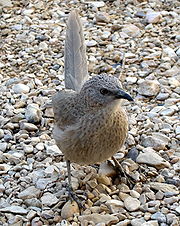
The babblers or timaliids are somewhat diverse in size and coloration, but are characterised by soft fluffy plumage. There are about 274 species worldwide and 1 species which occurs in Oman.
- Arabian BabblerArabian BabblerThe Arabian Babbler is a passerine bird belonging to the genus Turdoides, a genus of Old World babblers.It is 26–29 cm long with a wingspan of 31-33.5 cm and a weight of 64-83 grams. It has a fairly long curved bill, a long tail, rounded wings and strong legs and feet. The plumage...
Turdoides squamiceps
Penduline tits
Order: Passeriformes. Family: RemizidaeThe penduline tits are a group of small passerine birds, related to the true tits. They are insectivores. There are about 13 species worldwide and 1 species which occurs in Oman.
- Eurasian Penduline-Tit Remiz pendulinus (A)
Sunbirds
-_male_(breeding)_on_kapok_(ceiba_pentandra)_in_kolkata_i_img_1893.jpg)
The sunbirds and spiderhunters are very small passerine birds which feed largely on nectar, although they will also take insects, especially when feeding young. Flight is fast and direct on their short wings. Most species can take nectar by hovering like a hummingbird, but usually perch to feed. There are about 131 species worldwide and 4 species which occur in Oman.
- Nile Valley SunbirdNile Valley SunbirdThe Nile Valley Sunbird is a species of bird in the Nectariniidae family. It is found in Djibouti, Egypt, Eritrea, Ethiopia, Oman, Saudi Arabia, Somalia, Sudan, and Yemen....
Hedydipna metallica - Palestine SunbirdPalestine SunbirdThe Palestine Sunbird or Northern Orange-tufted Sunbird is a small passerine bird of the sunbird family which is found in parts of the Middle East and sub-Saharan Africa...
Cinnyris oseus - Shining SunbirdShining SunbirdThe Shining Sunbird is a species of bird in the Nectariniidae family.It is found in Djibouti, Egypt, Eritrea, Ethiopia, Kenya, Oman, Saudi Arabia, Somalia, Sudan, Uganda, and Yemen.-References:...
Cinnyris habessinicus - Purple SunbirdPurple SunbirdThe Purple Sunbird is a small sunbird. Like other sunbirds they feed mainly on nectar, although they will also take insects, especially when feeding young. They have a fast and direct flight and can take nectar by hovering like a hummingbird but often perch at the base of flowers...
Cinnyris asiaticus
White-eyes
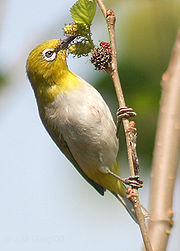
The white-eyes are small and are mostly of undistinguished appearance, the plumage above being generally either some dull color like greenish olive, but some species have a white or bright yellow throat, breast or lower parts, and several have buff flanks. As their name suggests many species have a white ring around the eyes. There are about 96 species worldwide and 2 species which occur in Oman.
- White-breasted White-eyeWhite-breasted White-eyeThe Abyssinian White-eye or White-breasted White-eye is a small passerine bird belonging to the genus Zosterops in the white-eye family Zosteropidae. It is native to north-east Africa and southern Arabia....
Zosterops abyssinicus - Oriental White-eyeOriental White-eyeThe Oriental White-eye, Zosterops palpebrosus, is a small passerine bird in the white-eye family. It is a resident breeder in open woodland in tropical Asia east from India to China and Indonesia. They forage in small groups, feeding on nectar and small insects. They are easily identified by the...
Zosterops palpebrosus
Old World orioles
Order: Passeriformes. Family: OriolidaeThe Old World Orioles are colourful passerine birds. They are not related to the New World orioles. There are about 30 species worldwide and 1 species which occurs in Oman.
- Eurasian Golden Oriole Oriolus oriolus
Shrikes

Shrikes are passerine birds known for their habit of catching other birds and small animals and impaling the uneaten portions of their bodies on thorns. A typical shrike's beak is hooked, like a bird of prey. There are about 30 species worldwide and 8 species which occur in Oman.
- Red-backed ShrikeRed-backed ShrikeThe Red-backed Shrike is a carnivorous passerine bird and member of the shrike family Laniidae.English common names include 'Wariangle' and 'worrier'.-Description:...
Lanius collurio - Isabelline ShrikeIsabelline ShrikeThe Isabelline Shrike is a member of the shrike family . It is the eastern equivalent of the Red-backed Shrike with which it used to be considered conspecific....
Lanius isabellinus - Bay-backed ShrikeBay-backed ShrikeThe Bay-backed Shrike, Lanius vittatus, is a member of the bird family Laniidae, the shrikes, resident in South Asia.-Description:It is smallish shrike at 17 cm, maroon-brown above with a pale rump and long black tail with white edges. The underparts are white, but with buff flanks.The crown...
Lanius vittatus (A) - Long-tailed ShrikeLong-tailed ShrikeThe Long-tailed Shrike or the Rufous-backed Shrike is a member of the bird family Laniidae, the shrikes. The eastern or Himalayan race, L. s...
Lanius schach (A) - Southern Grey ShrikeSouthern Grey ShrikeThe Southern Grey Shrike, Lanius meridionalis, is a member of the shrike family.It is closely related to the Great Grey Shrike, Lanius excubitor, with which it used to be considered conspecific; where they co-occur, they do not interbreed and are separated by choice of habitat.The race L. m....
Lanius meridionalis- Steppe Grey Shrike Lanius (meridionalis) pallidirostris
- Lesser Grey ShrikeLesser Grey ShrikeThe Lesser Grey Shrike is a member of the shrike family Laniidae.It is similar in appearance to the Great Grey Shrike Lanius excubitor and the Southern Grey Shrike L. meridionalis...
Lanius minor - Masked ShrikeMasked ShrikeThe Masked Shrike, Lanius nubicus, is a member of the shrike family Laniidae. It breeds in southeastern Europe and the eastern end of the Mediterranean, with a separate population in western Iran. It is a common species in Turkey, Cyprus, Israel and Syria...
Lanius nubicus - Woodchat ShrikeWoodchat ShrikeThe Woodchat Shrike is a member of the shrike family Laniidae.The Woodchat breeds in southern Europe, the Middle East and northwest Africa, and winters in tropical Africa. It breeds in open cultivated country, preferably with orchard trees and some bare or sandy ground.This migratory medium-sized...
Lanius senator
Bushshrikes and allies
Order: Passeriformes. Family: MalaconotidaeBushshrikes are similar in habits to shrikes, hunting insects and other small prey from a perch on a bush. Although similar in build to the shrikes, these tend to be either colourful species or largely black; some species are quite secretive. There are about 46 species worldwide and 1 species which occurs in Oman.
- Black-crowned TchagraBlack-crowned TchagraThe Black-crowned Tchagra is a bushshrike. This family of passerine birds is closely related to the true shrikes in the family Laniidae, and was once included in that group....
Tchagra senegala
Drongos
Order: Passeriformes. Family: DicruridaeThe drongos are mostly are black or dark grey in colour, sometimes with metallic tints. They have long forked tails, and some Asian species have elaborate tail decorations. They have short legs and sit very upright whilst perched, like a shrike. They flycatch or take prey from the ground. There are about 24 species worldwide and 1 species which occurs in Oman.
- Black DrongoBlack DrongoThe Black Drongo , also known as the King Crow, is a small Asian passerine bird of the drongo family Dicruridae. Previously considered a subspecies of the African Fork-tailed Drongo , it is now recognized as a full species...
Dicrurus macrocercus (A)
Crows, ravens and magpies
Order: Passeriformes. Family: CorvidaeCorvidae
Corvidae is a cosmopolitan family of oscine passerine birds that contains the crows, ravens, rooks, jackdaws, jays, magpies, treepies, choughs and nutcrackers. The common English names used are corvids or the crow family , and there are over 120 species...
The Corvidae family includes crow
Crow
Crows form the genus Corvus in the family Corvidae. Ranging in size from the relatively small pigeon-size jackdaws to the Common Raven of the Holarctic region and Thick-billed Raven of the highlands of Ethiopia, the 40 or so members of this genus occur on all temperate continents and several...
s, raven
Raven
Raven is the common name given to several larger-bodied members of the genus Corvus—but in Europe and North America the Common Raven is normally implied...
s, jay
Jay
The jays are several species of medium-sized, usually colorful and noisy, passerine birds in the crow family Corvidae. The names jay and magpie are somewhat interchangeable, and the evolutionary relationships are rather complex...
s, chough
Chough
The Red-billed Chough or Chough , Pyrrhocorax pyrrhocorax, is a bird in the crow family; it is one of only two species in the genus Pyrrhocorax...
s, magpie
Magpie
Magpies are passerine birds of the crow family, Corvidae.In Europe, "magpie" is often used by English speakers as a synonym for the European Magpie, as there are no other magpies in Europe outside Iberia...
s, treepie
Treepie
The treepies comprise four closely related genera of long-tailed passerine birds in the family Corvidae...
s, nutcracker
Nutcracker (bird)
The nutcrackers are a genus of two species of passerine bird, in the family Corvidae, related to the jays and crows. One, the Spotted Nutcracker , occurs in Europe and Asia, the other, Clark's Nutcracker , in western North America.The most important food resources for both these species are the...
s, and ground jay
Ground jay
The ground jays or ground choughs belong to a distinct group of the passerine order of birds in the genus Podoces of the crow family Corvidae...
s. Corvids are above average in size for the bird order Passeriformes. Some of the larger species show high levels of learning behavior. There are about 119 species worldwide and 4 species which occur in Oman.
- Eurasian Magpie Pica pica (A)
- House CrowHouse Crowthumb|300px|Bangalore, IndiaThe House Crow , also known as the Colombo Crow is a common bird of the Crow family that is of Asian origin but now found in many parts of the world, where they arrived assisted by shipping. It is between the Jackdaw and the Carrion Crow in size but is relatively...
Corvus splendens - Brown-necked RavenBrown-necked RavenThe Brown-necked Raven is a larger bird than the Carrion Crow though not as large as the Common Raven. It has similar proportions to the common raven but the bill is not so large or deep and the wings tend to be a little more pointed in profile...
Corvus ruficollis - Fan-tailed RavenFan-tailed RavenThe Fan-tailed Raven is a passerine bird of the crow family native to Eastern Africa and the Arabian Peninsula. Like the Chihuahuan Raven it is one of the smaller species , in fact it is about the same size as a Carrion Crow but with a much thicker bill, shorter tail and much larger...
Corvus rhipidurus
Starlings

Starlings are small to medium-sized passerine birds. Their flight is strong and direct, and they are very gregarious. Their preferred habitat is fairly open country. They eat insects and fruit. Plumage is typically dark with a metallic sheen. There are about 114 species worldwide and 8 species which occur in Oman.
- Bank MynaBank MynaBank Myna is a myna found in South Asia. It is smaller but similar in colouration to the Common Myna but differs in having a brick red bare skin behind the eye in place of yellow. It is greyer on the underside and in this and in the presence of a slight tuft of feathers bears some resemblance to...
Acridotheres ginginianus (I) - Common MynaCommon MynaThe Common Myna or Indian Myna also sometimes spelled Mynah, is a member of family Sturnidae native to Asia. An omnivorous open woodland bird with a strong territorial instinct, the Myna has adapted extremely well to urban environments...
Acridotheres tristis (I) - Brahminy StarlingBrahminy StarlingThe Brahminy Myna or Brahminy Starling is a member of the starling family of birds. It is creamy orange bird with a black cap and a slight crest. They are usually seen in pairs or small flocks in open habitats on the plains of South Asia.-Description:This myna is pale buff creamy with a black cap...
Temenuchus pagodarum (A) - Rosy StarlingRosy StarlingThe Rosy Starling or Rose-coloured Starling is a passerine bird in the starling family Sturnidae. It is sometimes given its own, monotypic genus Pastor...
Pastor roseus - European StarlingEuropean StarlingThe Common Starling , also known as the European Starling or just Starling, is a passerine bird in the family Sturnidae.This species of starling is native to most of temperate Europe and western Asia...
Sturnus vulgaris - Wattled StarlingWattled StarlingThe Wattled Starling is a nomadic resident in eastern and southern Africa. It is a species of grassland, open woodland and cultivation....
Creatophora cinerea - Violet-backed StarlingViolet-backed StarlingThe Violet-backed Starling , also known as the Plum-coloured Starling or Amethyst Starling, is a relatively small species of starling in the Sturnidae family. This strongly sexually dimorphic species is found widely in woodland of mainland sub-Saharan Africa.-References:* BirdLife International 2004....
Cinnyricinclus leucogaster (A) - Tristram's Starling Onychognathus tristramii
Sparrows
_at_bharatpur_i_img_5262.jpg)
Sparrow
Sparrow
The sparrows are a family of small passerine birds, Passeridae. They are also known as true sparrows, or Old World sparrows, names also used for a genus of the family, Passer...
s are small passerine birds. In general, sparrows tend to be small, plump, brown or grey birds with short tails and short powerful beaks. Sparrows are seed-eaters, and they also consume small insects. There are 35 species worldwide and 4 species which occur in Oman.
- House SparrowHouse SparrowThe House Sparrow is a bird of the sparrow family Passeridae, found in most parts of the world. One of about 25 species in the genus Passer, the House Sparrow occurs naturally in most of Europe, the Mediterranean region, and much of Asia...
Passer domesticus - Spanish SparrowSpanish SparrowThe Spanish Sparrow or Willow Sparrow is a passerine bird of the sparrow family Passeridae. It is found in the Mediterranean region and southwest and central Asia...
Passer hispaniolensis - Chestnut-shouldered PetroniaChestnut-shouldered PetroniaThe Yellow-throated Sparrow or Chestnut-shouldered Petronia is a species of sparrow found in Asia.- Description :...
Petronia xanthocollis - Pale RockfinchPale RockfinchThe Pale Rockfinch or Pale Rock Sparrow is a small sparrow found in the Middle East and Central Asia. It is the only living member of the genus Carpospiza. Some authorities include it in the genus Petronia...
Carpospiza brachydactyla
Weavers and allies
Order: Passeriformes. Family: PloceidaeThe weavers are small passerine birds related to the finch
Finch
The true finches are passerine birds in the family Fringillidae. They are predominantly seed-eating songbirds. Most are native to the Northern Hemisphere, but one subfamily is endemic to the Neotropics, one to the Hawaiian Islands, and one subfamily – monotypic at genus level – is found...
es. They are seed-eating birds with rounded conical bills. The males of many species are brightly coloured, usually in red or yellow and black, some species show variation in colour only in the breeding season. There are about 116 species worldwide and 1 species which occurs in Oman.
- Rueppell's WeaverRueppell's WeaverThe Rüppell's Weaver is a species of bird in the Ploceidae family.It is found in Djibouti, Eritrea, Ethiopia, Kenya, Oman, Saudi Arabia, Somalia, Sudan, and Yemen.-References:...
Ploceus galbula
Waxbills and allies

The estrildid finch
Estrildid finch
The estrildid finches are small passerine birds of the Old World tropics and Australasia. They can be classified as the family Estrildidae , or as a sub-group within the family Passeridae, which also includes the true sparrows....
es are small passerine birds of the Old World tropics and Australasia
Australasia
Australasia is a region of Oceania comprising Australia, New Zealand, the island of New Guinea, and neighbouring islands in the Pacific Ocean. The term was coined by Charles de Brosses in Histoire des navigations aux terres australes...
. They are gregarious and often colonial seed-eaters with short thick but pointed bills. They are all similar in structure and habits, but have a wide variation in plumage colours and pattern. There are about 141 species worldwide and 3 species which occur in Oman.
- African SilverbillAfrican SilverbillThe African Silverbill is a small passerine bird formerly considered conspecific with the Asian species Indian Silverbill, . This estrildid finch is a common resident breeding bird in dry savanna habitat, south of the Sahara Desert...
Euodice cantans - Indian SilverbillIndian SilverbillThe Indian Silverbill or White-throated Munia is a small passerine bird found in South Asia that was formerly considered to include the closely related African Silverbill . This estrildid finch is a common resident breeding bird in the dry regions of the Middle East and South Asia...
Euodice malabarica - Scaly-breasted MuniaScaly-breasted MuniaThe Scaly-breasted Munia or Spotted Munia known in the pet trade as Nutmeg Mannikin or Spice Finch is a sparrow-sized estrildid finch native to tropical Asia extending from India and Sri Lanka east to Indonesia and the Philippines...
Lonchura punctulata (I)
Finches

Finch
Finch
The true finches are passerine birds in the family Fringillidae. They are predominantly seed-eating songbirds. Most are native to the Northern Hemisphere, but one subfamily is endemic to the Neotropics, one to the Hawaiian Islands, and one subfamily – monotypic at genus level – is found...
es are seed-eating passerine birds, that are small to moderately large and have a strong beak, usually conical and in some species very large. All have 12 tail feathers and 9 primaries. These birds have a bouncing flight with alternating bouts of flapping and gliding on closed wings, and most sing well. There are 137 species worldwide and 7 species which occur in Oman.
- BramblingBramblingThe Brambling, Fringilla montifringilla, is a small passerine bird in the finch family Fringillidae.- Etymology :The common English name is probably derived from the German "brâma", meaning bramble or a thorny bush. It has also been called the Cock o' the North and the Mountain Finch.- Description...
Fringilla montifringilla - Golden-winged GrosbeakArabian GrosbeakThe Arabian Grosbeak or Arabian Golden-winged Grosbeak is a finch found in Saudi Arabia, Oman and Yemen. It is included as a subspecies in R...
Rhynchostruthus socotranus - Common RosefinchCommon RosefinchThe Common Rosefinch is the most widespread and common rosefinch of Europe, where it has spread westward from Asia in recent decades: it has even been recorded breeding in England once...
Carpodacus erythrinus - Eurasian SiskinEurasian SiskinThe Eurasian Siskin is a small passerine bird in the finch family Fringillidae. It is also called the European Siskin, Common Siskin or just Siskin. Other names include Black-headed Goldfinch, barley bird and aberdevine. It is very common throughout Europe and Asia...
Carduelis spinus (A) - European GoldfinchEuropean GoldfinchThe European Goldfinch or Goldfinch is a small passerine bird in the finch family.-Habitat and range:The goldfinch breeds across Europe, North Africa, and western and central Asia, in open, partially wooded lowlands. It is resident in the milder west of its range, but migrates from colder regions...
Carduelis carduelis (A) - Yemen SerinYemen SerinThe Yemen Serin is a species of finch in the Fringillidae family.It is found in Oman, Saudi Arabia, and Yemen.-References:* BirdLife International 2004. . Downloaded on 19 July 2007....
Serinus menachensis - Trumpeter FinchTrumpeter FinchThe Trumpeter Finch is a small passerine bird in the finch family Fringillidae.This bird breeds in the Canary Islands, across north Africa, and in the Middle East and into central Asia. There is a small European population in southern Spain...
Bucanetes githaginea
Buntings
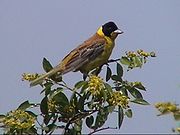
Emberizidae
The Emberizidae are a large family of passerine birds. They are seed-eating birds with a distinctively shaped bill.In Europe, most species are called buntings. In North America, most of the species in this family are known as sparrows, but these birds are not closely related to the sparrows, the...
The emberizids are a large family of passerine birds. They are seed-eating birds with a distinctively shaped bill. In Europe, most species are named as buntings. In North America, most of the species in this family are known as Sparrows, but these birds are not closely related to the Old World sparrows which are in the family Passeridae. Many emberizid species have distinctive head patterns. There are about 329 species worldwide and 13 species which occur in Oman.
- Grey-necked BuntingGrey-necked BuntingThe Grey-necked Bunting or Grey-hooded Bunting is a species of bird in the Emberizidae family. It breeds along a wide distribution range from the Caspian Sea to the Altai in Central Asia and winters in parts of Southern Asia. Like other buntings it is found in small flocks.-Description:This...
Emberiza buchanani (A) - Cinereous BuntingCinereous BuntingThe Cinereous Bunting, Emberiza cineracea, is a bird in the bunting family Emberizidae, a passerine family now separated by most modern authors from the finches Fringillidae. This species was discovered by Hugh Edwin Strickland.- Range :...
Emberiza cineracea (A) - Ortolan BuntingOrtolan BuntingThe Ortolan, or Ortolan Bunting, Emberiza hortulana, is a bird in the bunting family Emberizidae, a passerine family now separated by most modern authors from the finches, Fringillidae...
Emberiza hortulana - Cretzschmar's BuntingCretzschmar's BuntingThe Cretzschmar's Bunting, Emberiza caesia, is a passerine bird in the bunting family Emberizidae, a group now separated by most modern authors from the finches, Fringillidae....
Emberiza caesia (A) - House BuntingStriolated BuntingThe Striolated Bunting is a passerine bird in the bunting family Emberizidae, a group now separated by most modern authors from the finches, Fringillidae.- Distribution and habitat :...
Emberiza striolata - Cinnamon-breasted BuntingCinnamon-breasted BuntingThe Cinnamon-breasted Bunting is a species of bird in the Emberizidae family. It is found in Angola, Benin, Botswana, Burkina Faso, Burundi, Cameroon, Central African Republic, Chad, Republic of the Congo, Democratic Republic of the Congo, Ivory Coast, Djibouti, Egypt, Eritrea, Ethiopia, Gabon,...
Emberiza tahapisi - Little BuntingLittle BuntingThe Little Bunting, Emberiza pusilla, is a passerine bird. It belongs to the bunting and American sparrow family , a group separated by most modern authors from the true finches .-Description:...
Emberiza pusilla (A) - Rustic BuntingRustic BuntingThe Rustic Bunting, Emberiza rustica, is a passerine bird in the bunting family Emberizidae, a group now separated by most modern authors from the finches, Fringillidae....
Emberiza rustica (A) - Yellow-breasted BuntingYellow-breasted BuntingThe Yellow-breasted Bunting, Emberiza aureola, is an Eurasian passerine bird in the bunting family .This bird is similar in size to a Reed Bunting, but longer-billed...
Emberiza aureola - Black-headed BuntingBlack-headed BuntingThe Black-headed Bunting, Emberiza melanocephala, is a passerine bird in the bunting family Emberizidae, a group now separated by most modern authors from the finches, Fringillidae....
Emberiza melanocephala - Red-headed BuntingRed-headed BuntingThe Red-headed Bunting, Emberiza bruniceps, is a passerine bird in the bunting family Emberizidae, a group now separated by most modern authors from the finches, Fringillidae.It breeds in central Asia. It is migratory, wintering in India...
Emberiza bruniceps (A) - Reed BuntingReed BuntingThe Reed Bunting, Emberiza schoeniclus, is a passerine bird in the bunting family Emberizidae, a group now separated by most modern authors from the finches, Fringillidae....
Emberiza schoeniclus (A) - Corn BuntingCorn BuntingThe Corn Bunting, Miliaria calandra, is a passerine bird in the bunting family Emberizidae, a group now separated by most modern authors from the finches, Fringillidae...
Emberiza calandra

